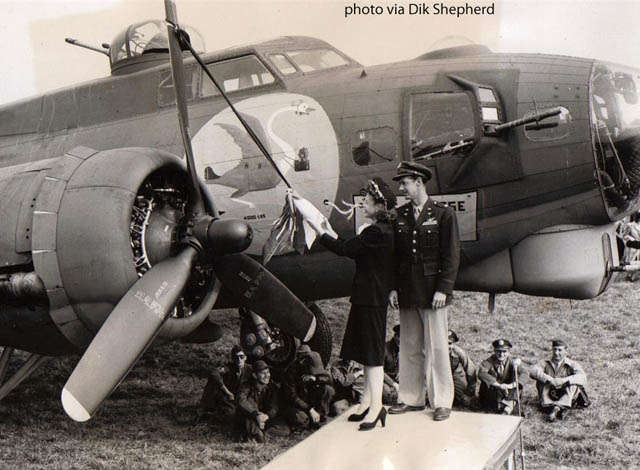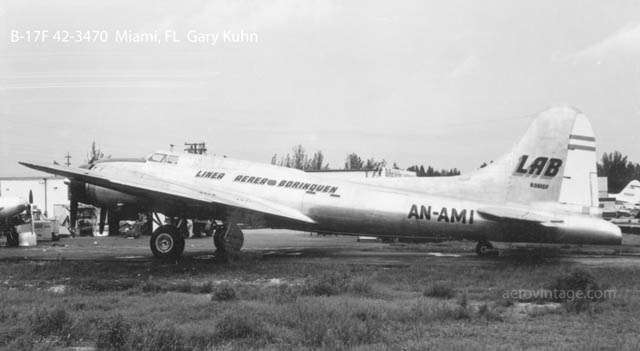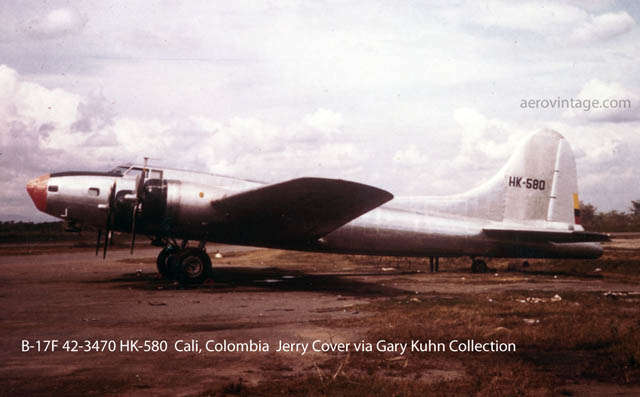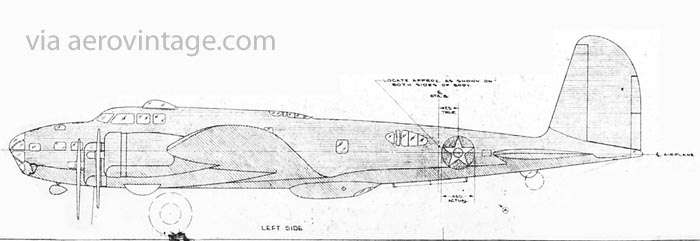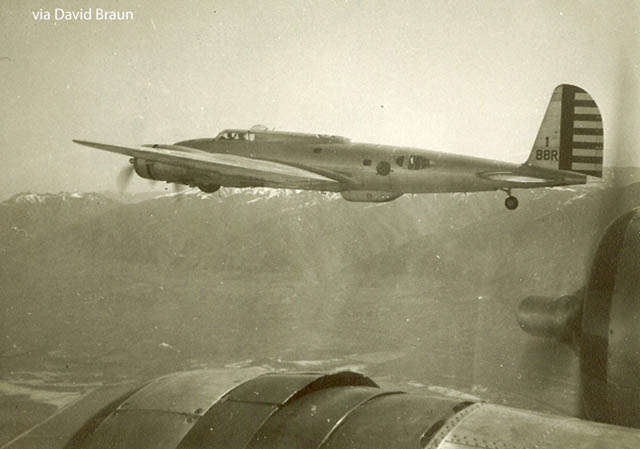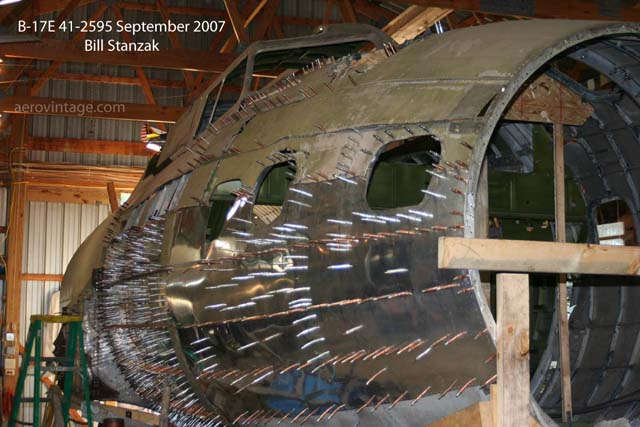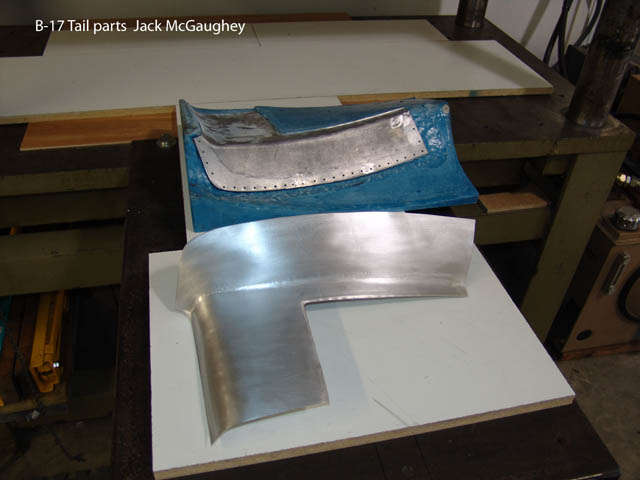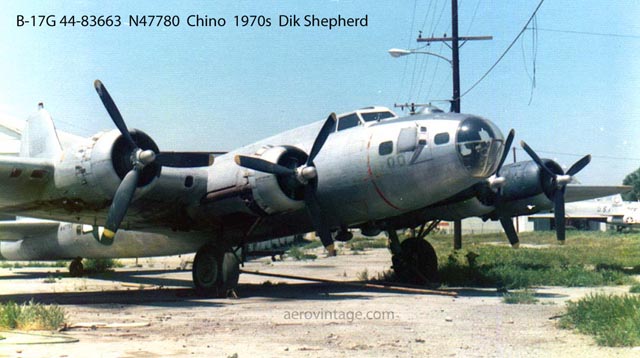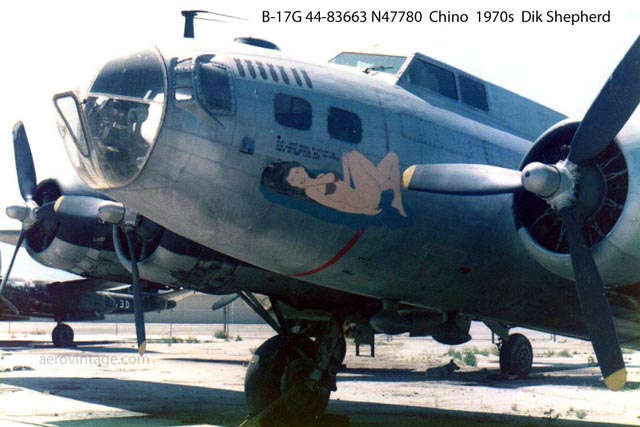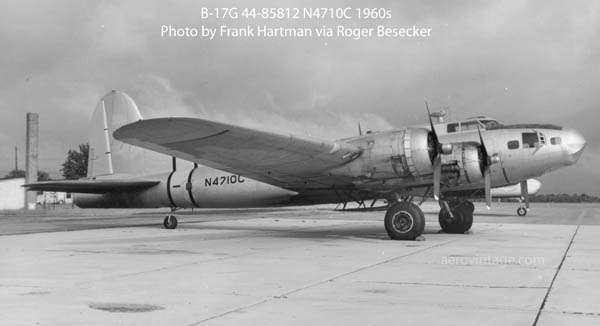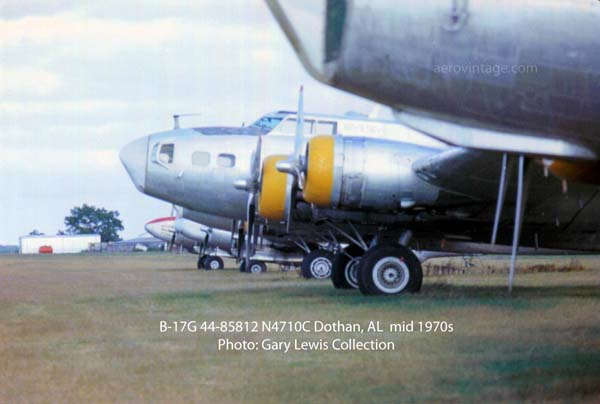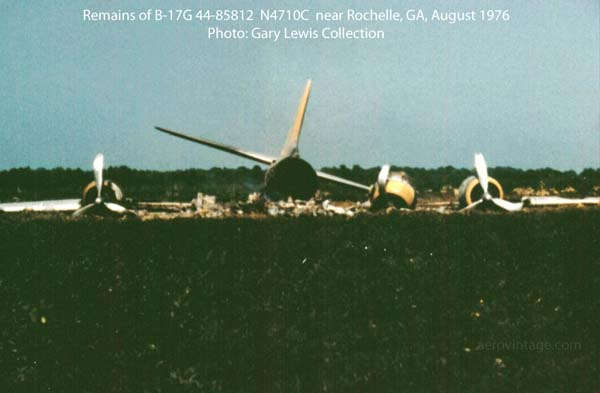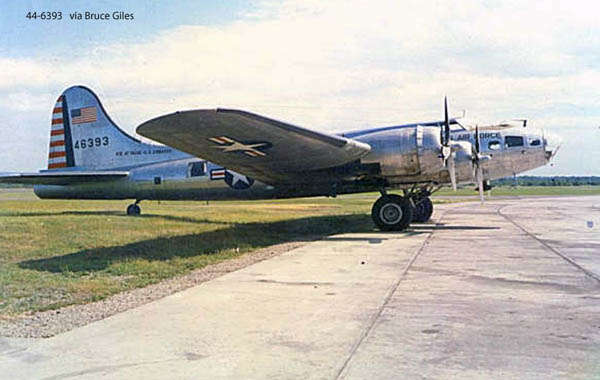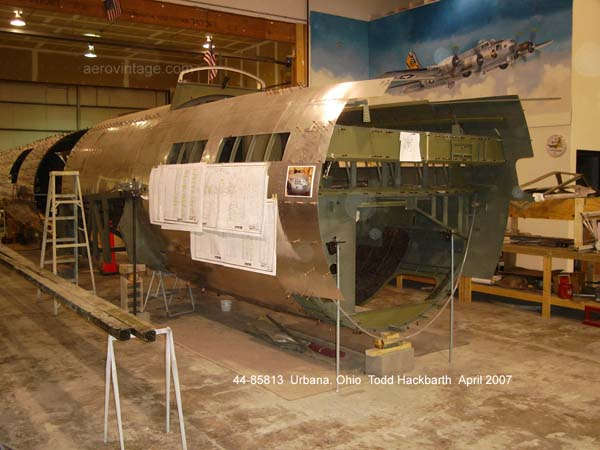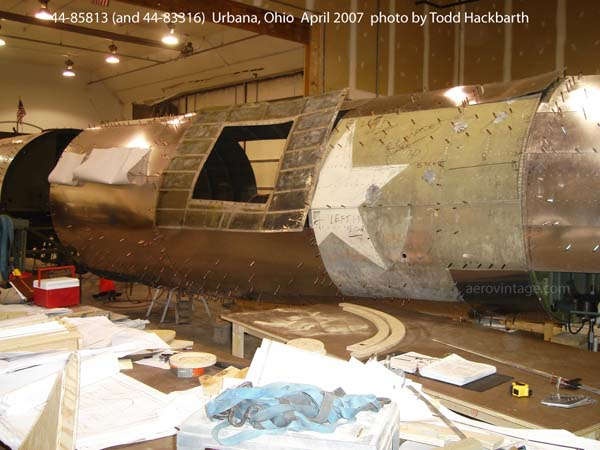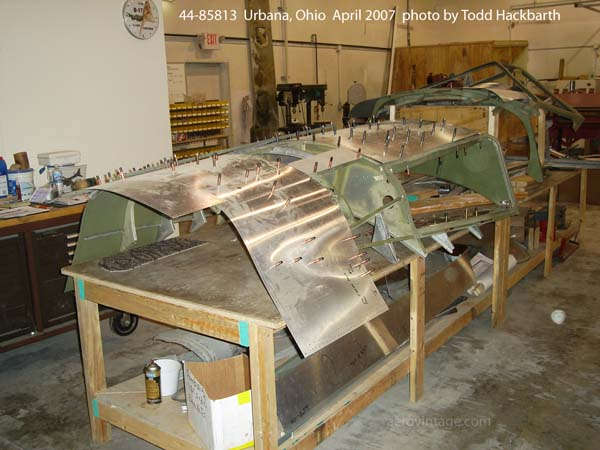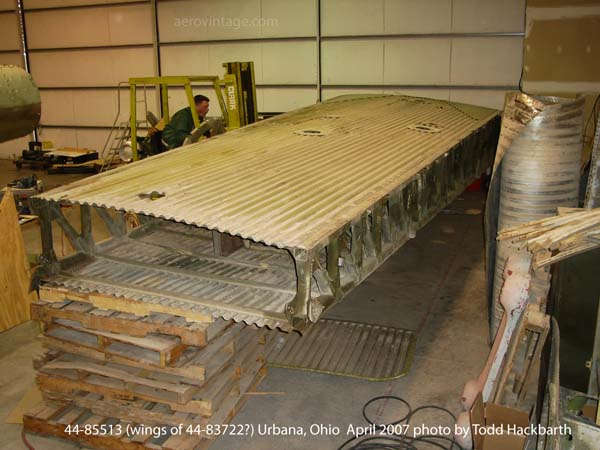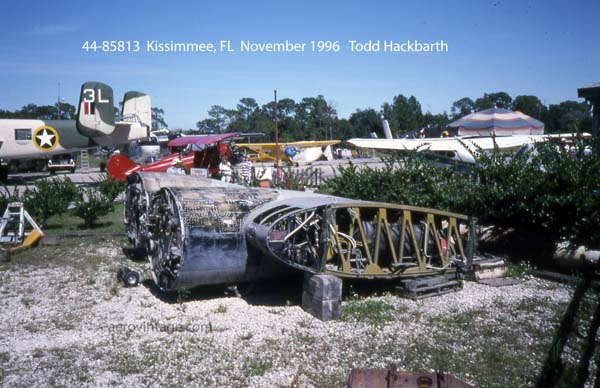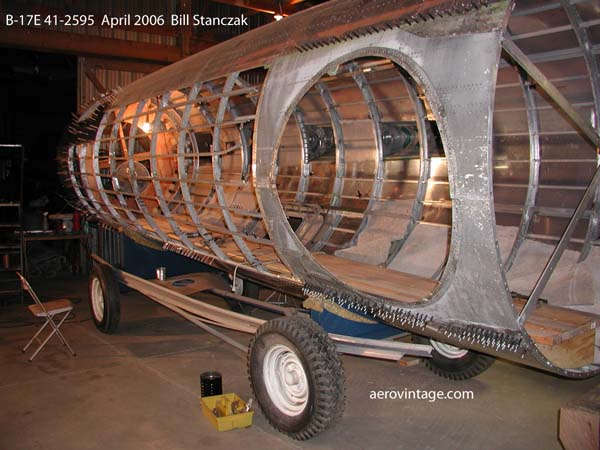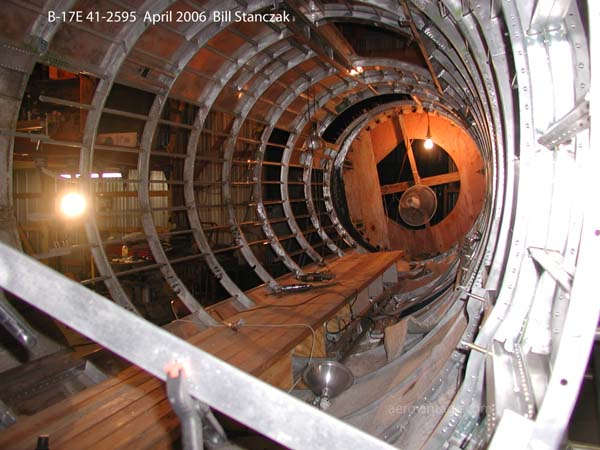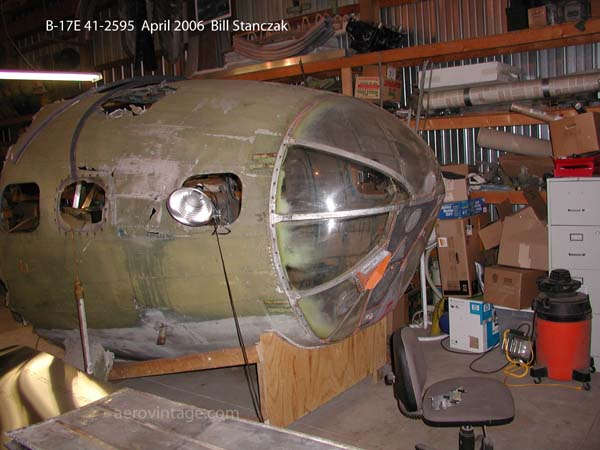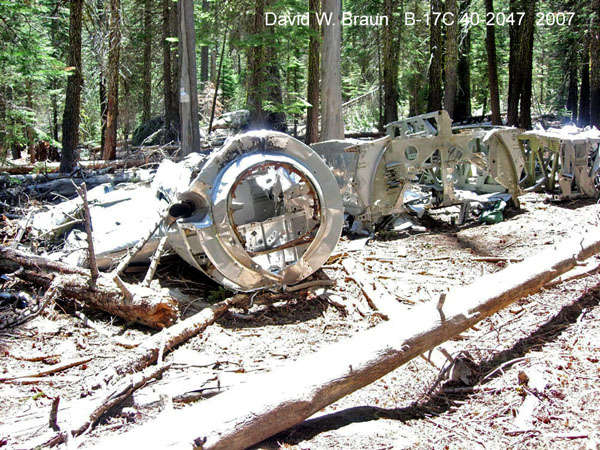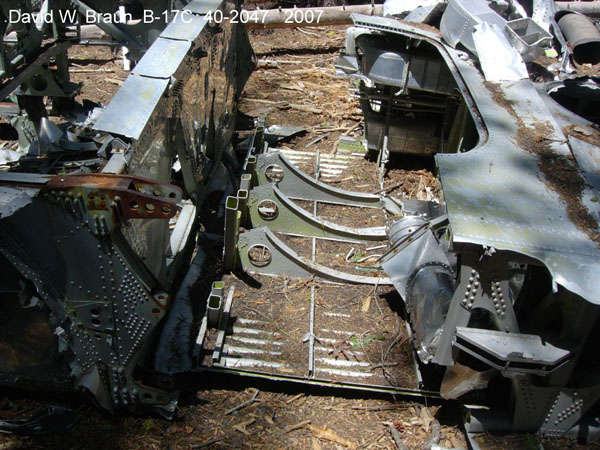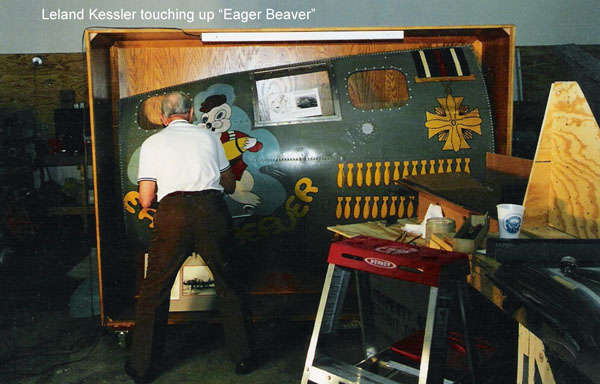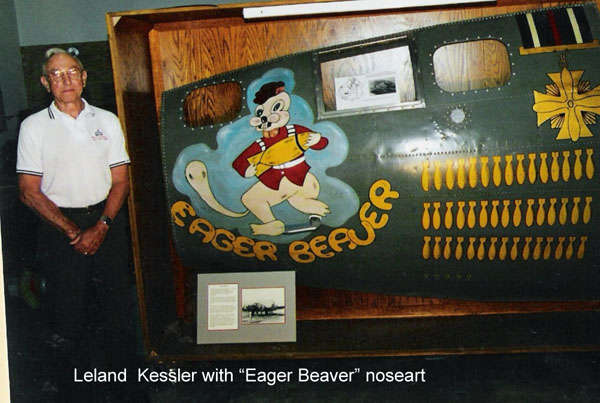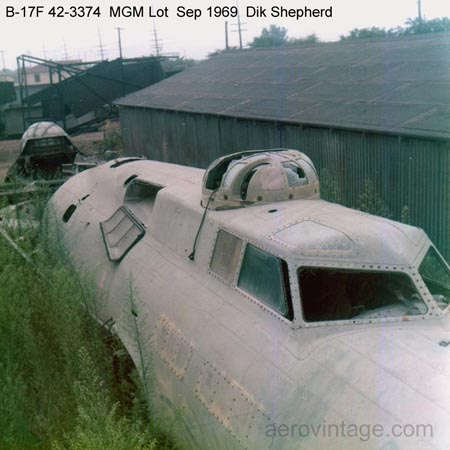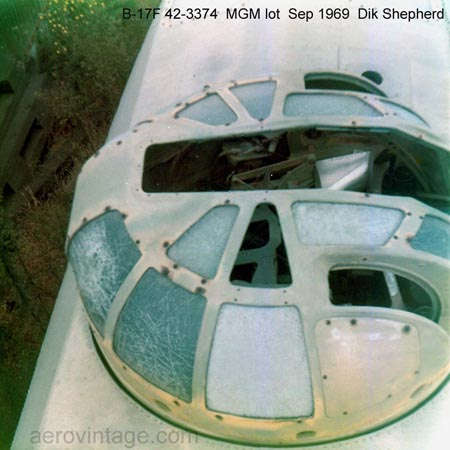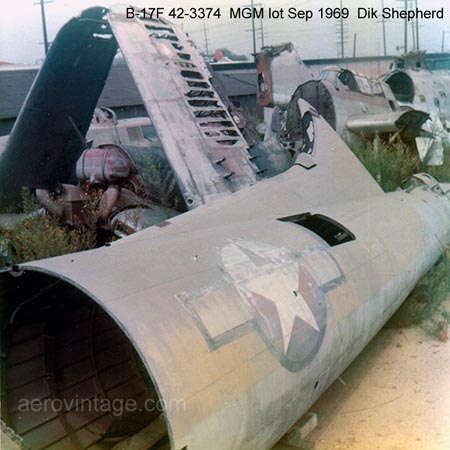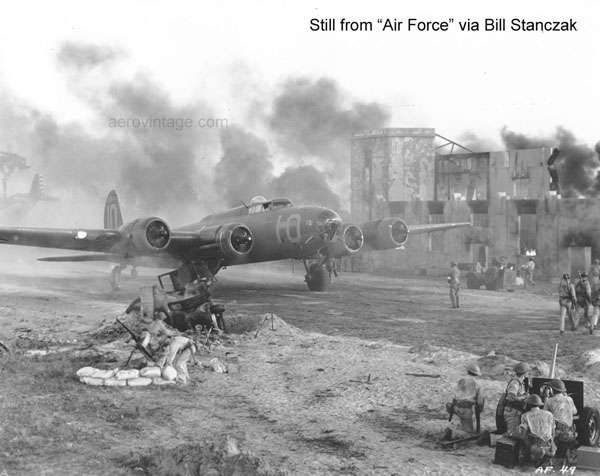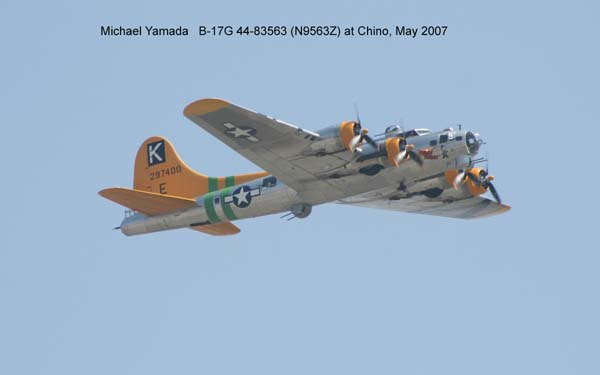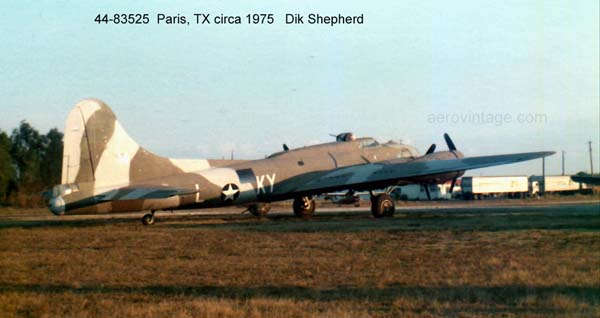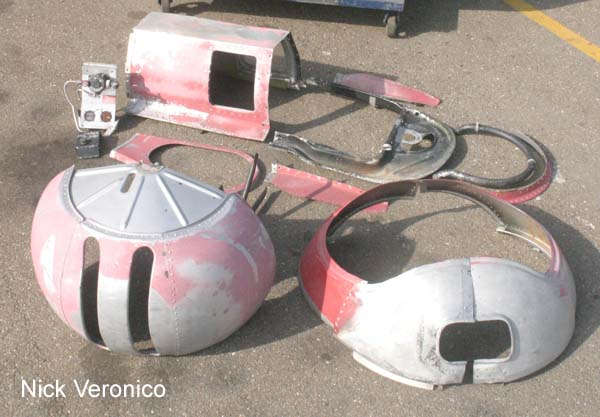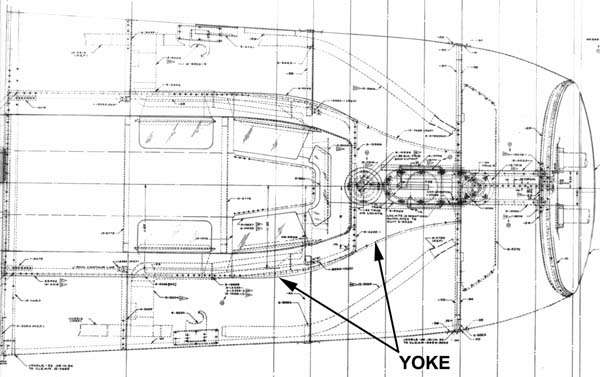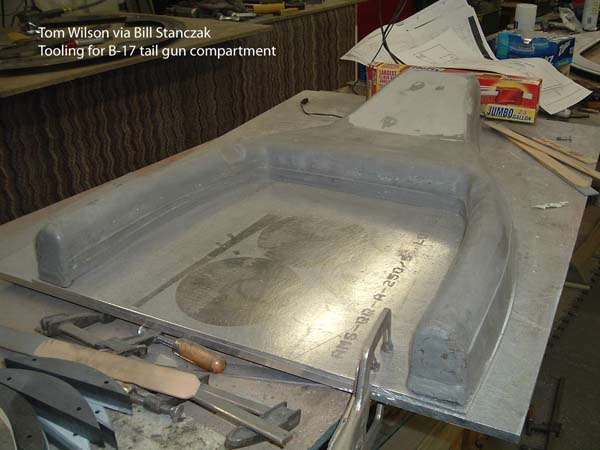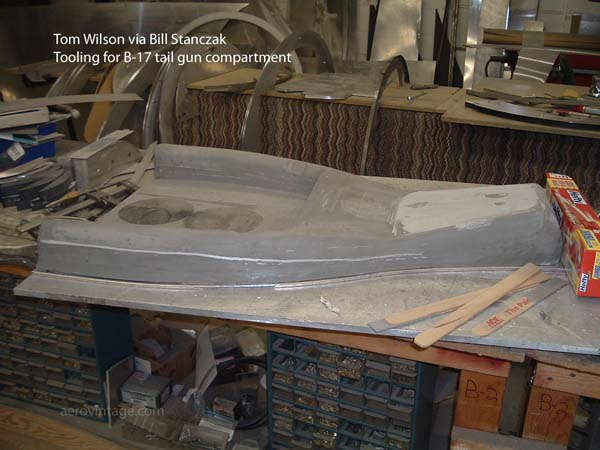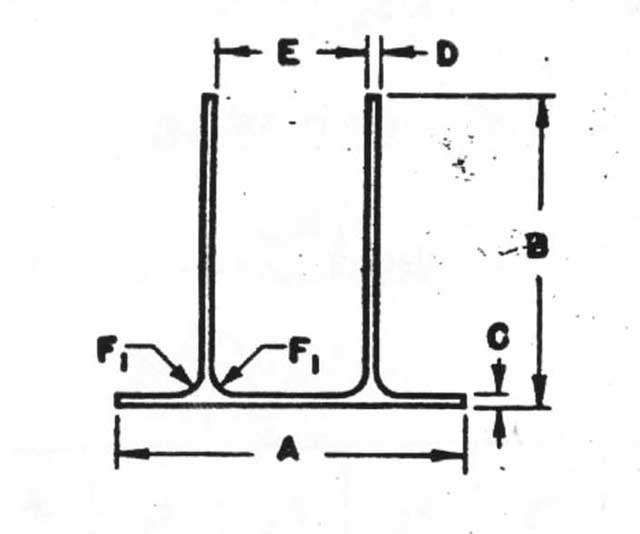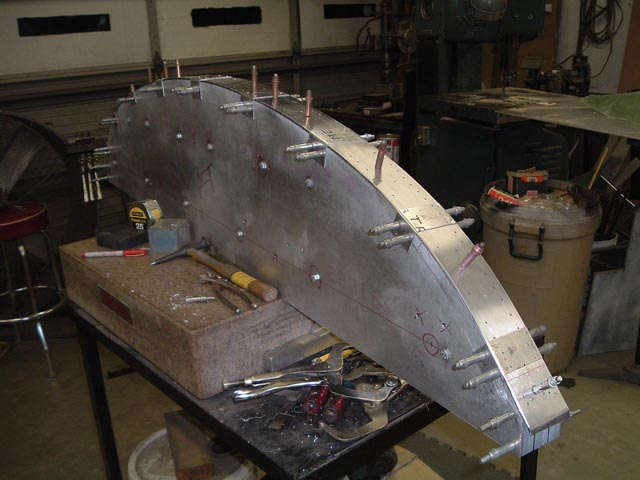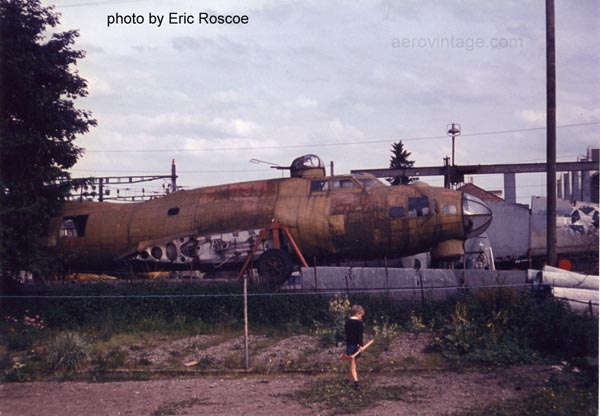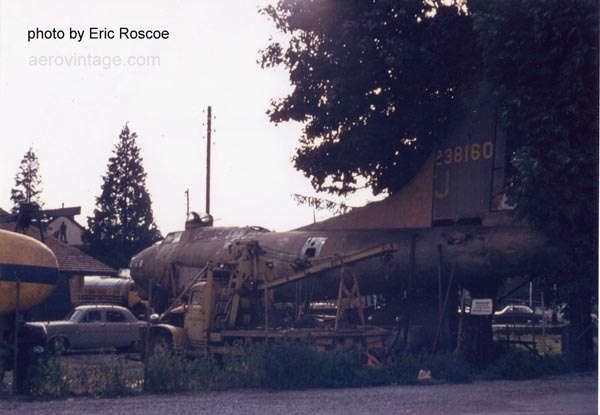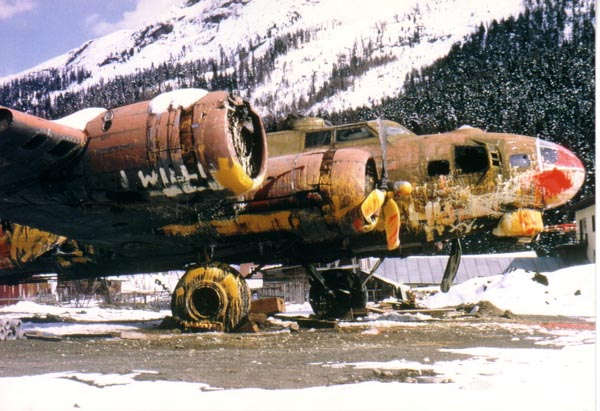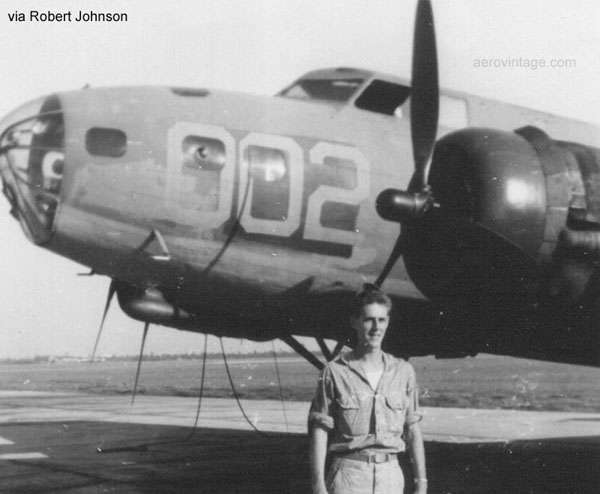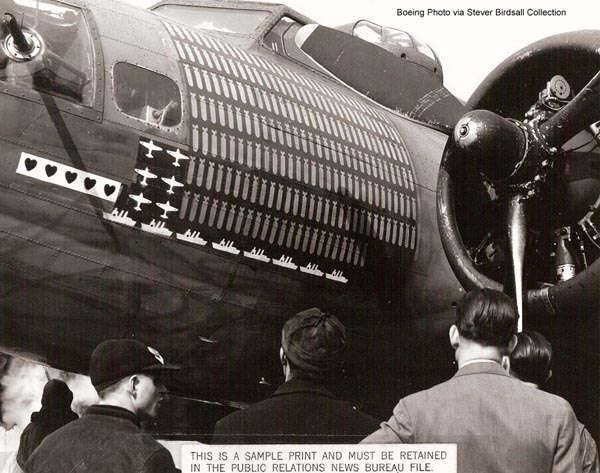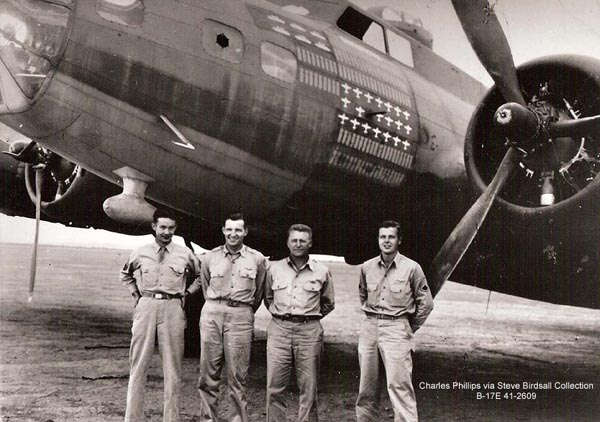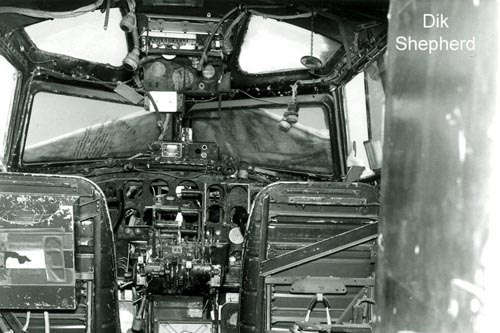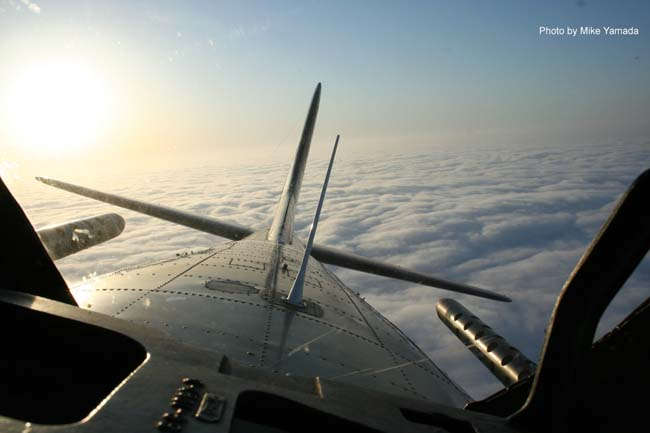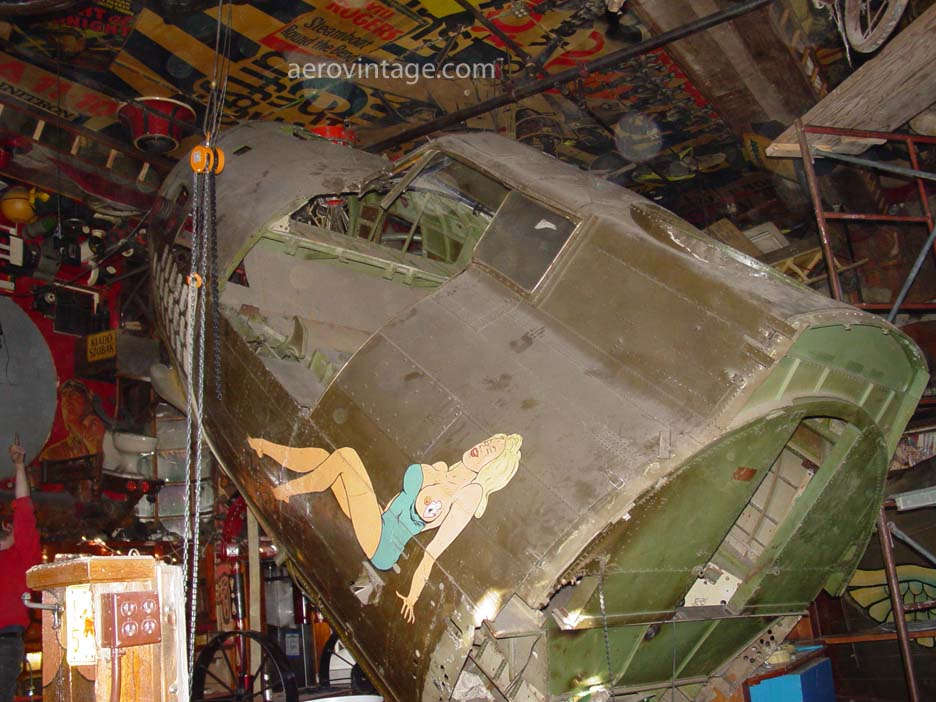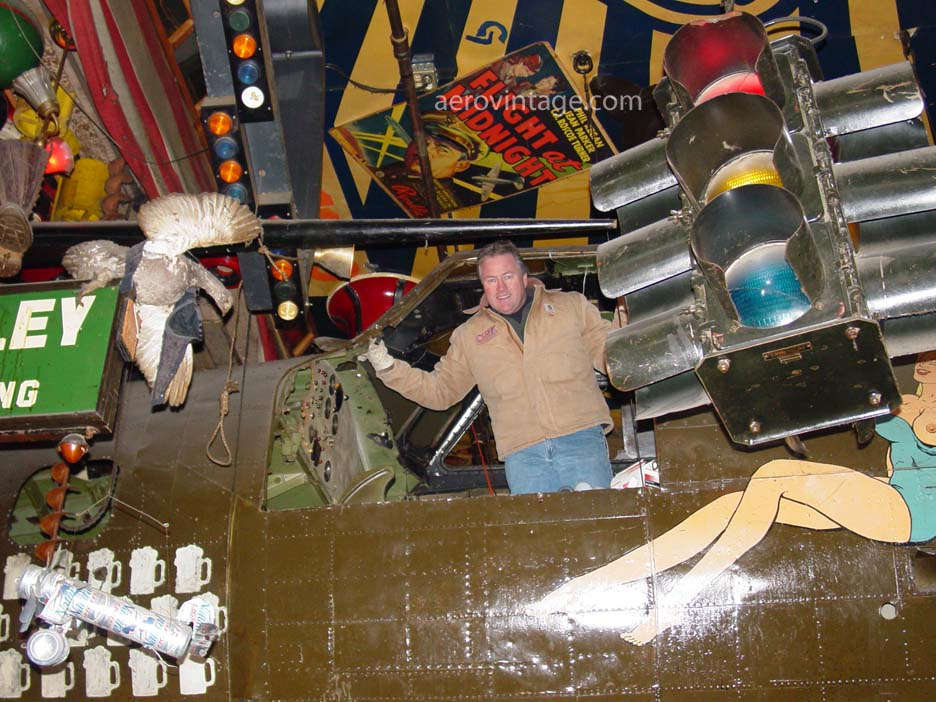
| site search by freefind | advanced |
AERO VINTAGE BOOKS
2007 B-17 NEWS
B-17 News Archive
2018 B-17 News
2017 B-17 News
2016 B-17 News
2015 B-17 News
2014 B-17 News
2013 B-17 News
2012 B-17 News
2011 B-17 News
2010 B-17 News
2009 B-17 News
2008 B-17 News
2007 B-17 News
2006 B-17 News
2005 B-17 News
2004 B-17 News
2003 B-17 News
2002 B-17 News
1997-2001 B-17 News
Back to the Main Page
We're including this page as an update point for B-17 news. We'll post information garnered from any variety of sources, and notate that source at the end of the item. If anyone has anything they'd like to add, please let us know.
B-17 Tour Information
- The Collings Foundation B-17G Nine-O-Nine, 44-83575 (N93012), is nearing the end of its 2007 Tour. Tour dates with the B-17, B-24, and B-25 for 2007 are posted. The B-17G, as well as the Collings B-24 and B-25, are working in the southeast in early November before the tour ends on November 14th for the year. For the most current information, jump to here for schedule information.
- The Commemorative (ex-Confederate) Air Force's B-17G Texas Raiders, 44-83872 (N7227C), remains in maintenance until further notice due to the B-17 Airworthiness Directive issued by the FAA (see below also). Jump to here for the most current information.
- The CAF's other B-17G, Sentimental Journey, 44-83514 (N9323Z), has no tour dates currently posted. The Arizona Wing's page can be found here for the only Wing information posted for Sentimental Journey.
- The Experimental Aircraft Association's B-17G Aluminum Overcast, 44-85740 (N5017N), has dates in Florida in early November, and then evidently is off tour for the year. Check out the most current information here.
- The Liberty Foundation has begun touring with the most recent B-17 restoration, Liberty Belle, B-17G 44-85734 (N390TH). Dates are posted for appearances in California in early November. Check out the current schedule here.
- The Yankee Air Force out of Willow Run, Michigan, operates the magnificent B-17G, 44-85829 (N3193G), Yankee Lady. The museum is still reeling from the devestating fire that destroyed the hangar facilities but fortunately spared both the B-17 and B-25. Plans are underway to rebuild. The B-17 has no appearances currently schedule on its web site. Jump to here for their most current information.
November 2007
- Lots of stuff again this month. This month is kind of like the "Circle of B-17", that is, just exactly like the "Circle of Life" thing going in the Disney Lion King thing except that Elton John doesn't sing about this one, at least not in public. But this month just proves that all B-17 stories are connected in a great scheme of cosmetic wonderment, or something like that. Strap in and hold on, 'cause it's a long one. This one will take some time to wade through and separate the bran from the raisins.
- We start with something that was in the September update: that of what we called Swoose II and a photo sent in by Dik Shepherd. B-17 Author Guy extroardinaire Steve Birdsall sent in some more information on this airplane. Turns out that it is B-17G 42-31844, and the photo depicts Margo Kurtz about to break a bottle of champagne (suspended from a propeller blade) and break it on the propeller boss. That's Lt. Col. Frank Kurtz standing next to her. The photo was taken at Lakeland AAF, Florida on February 3, 1944. It seems Lt. Col. Kurtz was about to take the newly-formed 463rd Bomb Group overseas to join the 15th Air Force in Italy. The complete text on the nose is "The Swoose" (1944 Model) It Flies?, text that was repeated just forward of the right waist window.
Steve notes that this B-17G was attached to the 772nd Bomb Squadron and ended up being salvaged overseas on May 16, 1945. Steve sends along the following photo from his collection, this one depicting the 1944 version of The Swoose in combat markings with the 15th Air Force. Steve notes that this photo came from John H. Mitchell, author of On Wings We Conquer, who had located Frank Kurtz and was able to obtain some photos from his personal collection for the book.
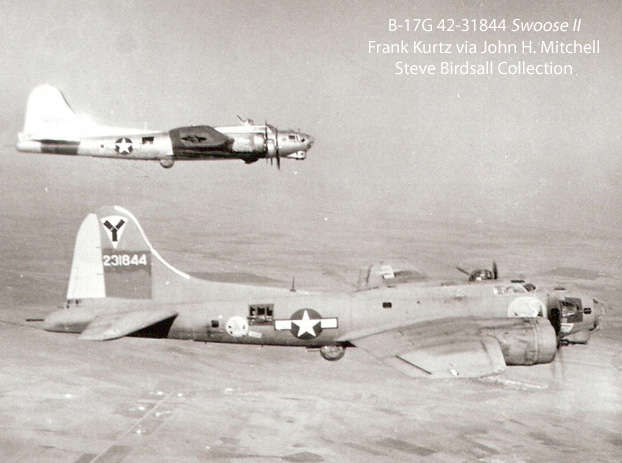
- Speaking of the photo of the B-17 with Margot and her champagne, reader Dennis Coley asked about the extra windows visible on the corners of the windscreen in that photo above. Termed as a "four-piece windscreen," the windows are a bit of a throwback to an earlier era, and they could be opened in flight to allow a runway to be seen if the rest of the windshield was iced over. Kind of a holdover from the open cockpit days, but also useful in the era of using alcohol to deice the windscreen. As for B-17s, these little windows seem to appear primarily on mid-production runs of B-17Gs. You'll also see the same setup on DC-3s and C-47s. Look here for an indepth discusssion on a topic most people would just shrug their shoulders at and say "huh?"
- Speaking of Steve Birdsall, he also provided a vintage photo of the Memphis Belle, otherwise known as 41-24485 circa 1962, that being all of sixteen years after Memphis got the airplane. (Perspective: sixteen years ago from right now was 1991, just yesterday in old people years.) Anyway, this is a nice view of the airplane and the markings it carried then.
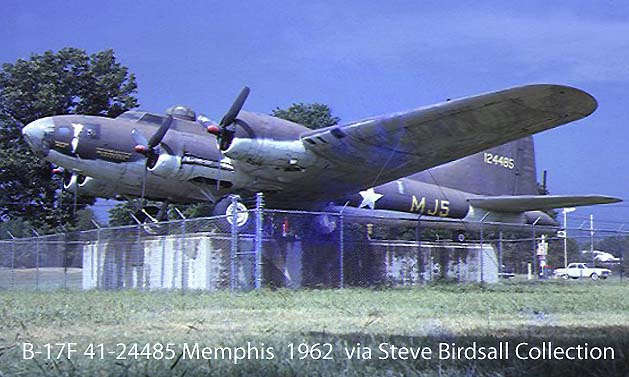
Note, if you will, the "M J 5" code on the fuselage. Reader and B-17 guy Tim Bivens helped fill in some information about these codes, postulating that they were 3rd Air Force codes for training B-17s based at McDill Field, Florida, during the war. Good information, as it ties into the next item.
- Speaking of McDill airplane codes, lets look at B-17F 42-3470, a B-17 that, not coincidently, had been based at McDill Field during World War II. This B-17F then went to the RFC after the war for disposal, and ended up being transferred to Montana State College at Bozeman. You would already know all of this if you bought the October 2007 issue of FlyPast Magazine that had an incredible article (okay, I wrote it) about this airplane, and it included this photo that I found in a local newspaper showing the airplane shortly after it arrived at Gallatin Field at Bozeman in 1945.
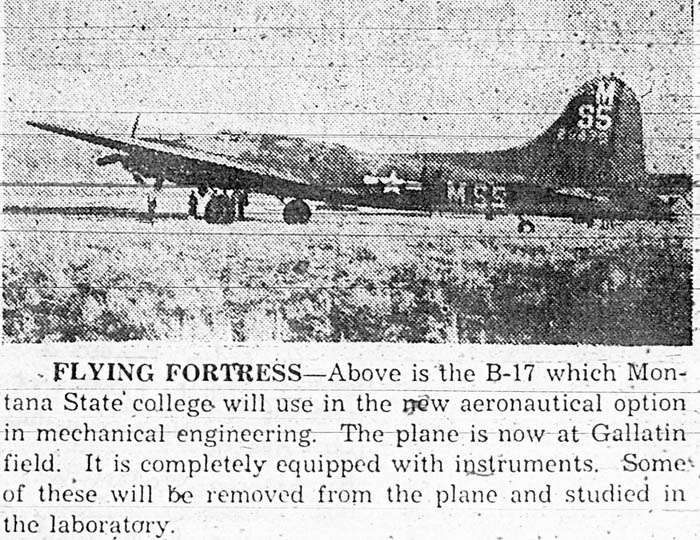
We all clearly understand that this photo is not clear, but you can make out the "M S 5" code on the tail. Now, the author of the FlyPast article wasn't sure whether the "M S 5" code somehow was really something to do with "M S" for "Montana State" but I think Timothy has cleared this up and educated that author feller just a bit. What's great about the internet is how quickly you can be educated.
Now, does anybody know the protocol (fancy word for methodology) behind the codes and how they broke down? Do the "M J 5" and "M S 5" codes mean these two airplanes were sister ships, or at least cousin ships, even second cousin ships, on the McDill flight line?
- Speaking of Tim Bivens, he has made a bit of a long time research project out of identifying and collecting photographs of those B-17s based at another bomber training base, this one at Dyersburg AAF in Tennessee. He's been working on this since the early days of Final Cut which was, like, sixteen years ago or actually about 1990 which is seventeen years ago. Anyway, Tim has found about 70 photos of individual B-17s out of the 240 or so that he has determined were based at Dyersburg. He is always looking for more, and if you have any hiding in your scrapbook, he'd sure like to hear from you. Those B-17s, by the way, often have a "DY" tail code quite prominent. You see, the "DY" stood for Dyersburg... Anyway, please let me know and I'll pass the word on to Tim and he'll rush to get ahold of you.
-
And speaking of the Bozeman B-17F, 42-3470, the discussions of the airplane that ensued from the article engendered a response from noted Latin American aviation guy Gary Kuhn, who passed along two photos of this airplane in later years. The first shows it in 1959 at Miami when it was wearing the Nicaraguan registration of AN-AMI as well as the U.S. registration of N9815F. Even though the FlyPast article covers the history of this airplane is some detail, there are some gaping holes in information, and one of them is why this airplane has the Nicaraguan registration.
And, another question, is what happened to this airplane? It last appeared in Colombia in the early 1960s, and then disappeared from view. Despite many inquiries to many people, the fate of this B-17F remains unknown. Presumably it crashed in Colombia and thus disappeared into obscurity. The last registration it wore was HK-580 and this photo from Gary Kuhn's collection shows the airplane in those markings.
- Speaking of Tim Bivens again, he also sent in an photo of an unusual B-17, this one with a pug nose only a mother could be proud of.
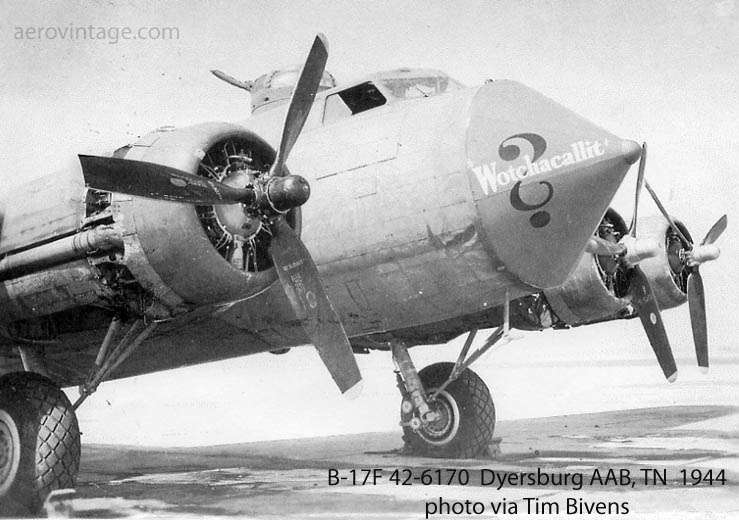
Now, this B-17F, 42-6170, was involved in a mid-air colliion at, wait for it..., Dyersburg AAF, Tennessee (see how we have this "Circle of B-17" thing going here?). This photo was taken on January 19, 1944, and depicts a very temporary nose cap placed over the badly damaged nose so it could, be flown to a repair depot at Mobile, Alabama, and fixed. Before you all go running to your The B-17 Flying Fortress Story by Roger Freeman and David Osborne, all it says is that this airplane was delivered on 8/11/43, went though the Cheyenne mod center on 8/15/43, and was "written off" on 1/26/44. I would suppose that what this means is that where I say above that the airplane was "flown to a repair depot at Mobile, Alabama, and fixed" what I really said was "flown to a repair depot at Mobile, Alabama, and scrapped."
- Speaking of scrapping B-17s, we, and by the word "we" I mean me and other people, would like to try and start our own little research project to locate some photos. Some photos of B-17s mostly being stored by the Army Air Forces and the United States Air Force. While much has been made of the vast fields of surplus bombers, many of them B-17s, that were set out for scrapping (i.e., Kingman, Walnut Ridge, Ontario), there were literally hundreds of brand new B-17s set aside by the AAF and USAF for furture use. The were trundled off from the production lines to places like Pyote Army Air Field (AAF), Texas and South Plains AAF, Lubbock, Texas and Garden City AAF, Kansas and Patterson Field, Ohio and Syracuse, New York and Altus AAF, Oklahoma. By 1948 or 1949, many of these fields had been emptied and closed, the stored B-17s having been consolidated primarily at Pyote, Texas. What we, by which I mean me and actually somebody else, are lacking is any photographs of these B-17s being held in storage. So before you go looking through your files for those "DY" coded B-17 photos, take some time and look for any photos of postwar B-17s being held in AAF/USAF storage for future use. And future use they did get, as the USAF drew from this inventory for its 1950 supply of DB-17Ps, QB-17Ls, QB-17Ns, VB-17Gs, SB-17Gs, and ETB-17Gs and JTB-17Gs. You know, all those ones. Again, please let me know if you know of any such photos and if you can, send 'em on in. We will post whatever surfaces right here. Well, not actually right here because this space is already taken, but right there probably in a 2008 update.
- Speaking of JTB-17Gs, long before there were JTB-17Gs there were B-17Cs, and the subject of B-17Cs is growing quickly, rising like bread with lots of yeast in it. Rumors are flying about the B-17C project that has only been alluded to here once in a while out of respect for the little group that has been exploring the very real possibility of creating, not restoring, a B-17C. There may be some B-17C parts in it, but in the days of scratch-built P-40s, can scratch built B-17Cs be ruled out? The technology is there, the craftsmen, the raw materials, the vision, mainly the vision, is there. What is possibly lacking just a little bit is the money, but, well, money is money. Money is only something kind of boring you can change into something really exciting like a Winnebago or a B-17C. And just how many people really want to see a Winnebago fly? Aside from some of those NASCAR folks, probably not too many. But a B-17C, with that very 1930s, very angular, some might say beautiful, airplane, with polished metal and Air Corps tail stripes? Yeah, there might be a few who want to see it back in the air. You show up at Oshkosh with a B-17C and you're gonna get some free Bratwurst, guaranteed.
Okay, so maybe we should start with a show of hands. Just how many people would seriously contribute in some way to getting a B-17C constructed? You can take 2 guys who pop a million each, or 2,000 guys who pop $1,000 each, or 200,000 guys who pop $10 each. Anyway you cut it, it's $2,000,000. Is there room out there for a non-profit B-17C Flying Museum, folks? I know what you're thinking, "is that math right?" Well, I'm probably not the person who can answer that question but if you have any opinions on the math or the B-17C thing, post them right here at the newly added B-17C Project forum page, and start thinking big. Or wide, like 103 feet wide.
- Speaking of B-17Cs, Bill Stanczak sent in an interesting factory drawing of a B-17C with some details about the factory paint finsih for Army Air Corps B-17Cs. Though these airplanes were originally delivered in a natural metal finish, those that went back to Boeing in early 1941 for modifications were repainted in the new olive drab and gray scheme for the war that was on the horizon. Click on the small photo here for the giant photo out there in cyberspace.
- Speaking once more of B-17Cs, Bill Stanczak was also kind enough to send in a drawing based on factory plans for the B-17C tail section. This type of detail work is difficult to do so Bill's effort should be appreciated by those who enjoy such technical information.
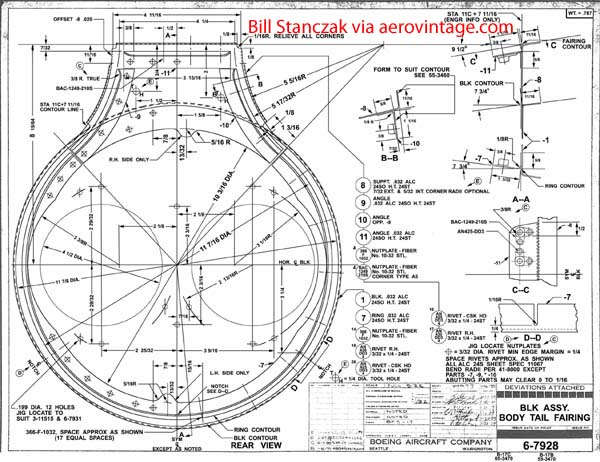
- Speaking once more without becoming annoying about B-17Cs, David Braun sent in this excellent vintage view of a B-17C taken from, probably, a B-17D because it has the cowl flap things. The subject aircraft does not have the cowl flaps. It is believed this photo was taken in Utah with the Wasatch mountains in the background. The 7th Bomb Group was headquartered at Fort Douglas, Utah, and the unit's aircraft were based nearby at the civil airport at Salt Lake City. The "88R" on the tail indicates this airplane was assigned to the 88th Reconaissance Squadron attached to that unit. This aircraft could actually be B-17C 40-2047, the remains of which are at a crash site near Placerville, California. I'm not saying it is, only that it is possible. This photo was probably late 1940, early 1941. Just a guess. Interesting photo. Beautiful airplane.
- Speaking of Bill Stanczak, he is also involved in the restoration of the Desert Rat and he sent in two pretty interesting photos of the progress of that B-17E project, otherwise known as 41-2595. The first shows the progress being made on reskinning the recently reattached nose structure. This photo was taken in September 2007:
And, then you have some photos of some new construction/rebuild efforts underway on both a Cheyenne tail turret and the standard "stinger" tail. This work is underway in Georgia by the skilled hands of Tom Wilson and some other talented people associated with him. The stinger tail, or one just like it, will end up on the Desert Rat. (These images have also been added to our special Rat's Nest.)
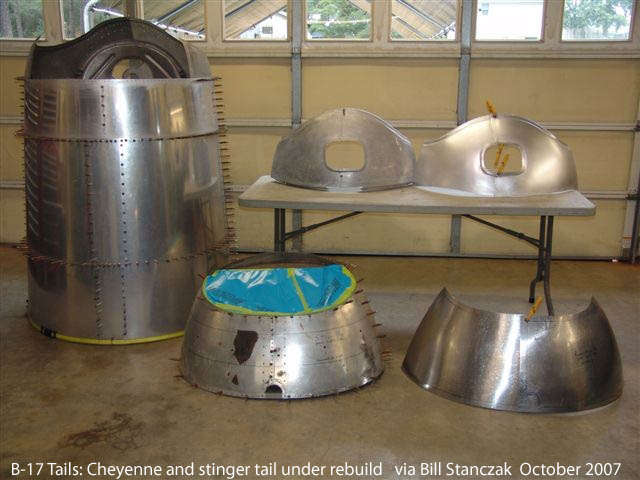
At least two, maybe more, of those skilled hands belong to Jack McGaughey who is working with Tom Wilson and Don Brooks on building up some tail gun compartment parts. Along with the above photo, this photo is one sent in by Jack showing some compartment components that have been hand built for Don Brooks.
This would appear to be a new-build section with the original piece and the forming block in the background.
- Speaking of guys who probably need tail turret parts, rumor has it that the tiny bits of B-17s not going into the Urbana, Ohio, project rebuilding B-17G 44-85813 might possibly have spawned yet another B-17 project. All the little leftover parts from Tom Reilly's stock of little leftover parts that didn't go to Urbana have been rumoured to have been sold to a South Carolina fellow who is starting his own, thank you very much, B-17 project. I wonder if it is a B-17C or maybe a Navy PB-1W.
- Speaking of Navy PB-1Ws, noted aviation author/collector/editor/photographer/researcher Nick Veronico sent in two little tidbits recently. The first is an advertisement he came across in a 1958 Aviation Week magazine:
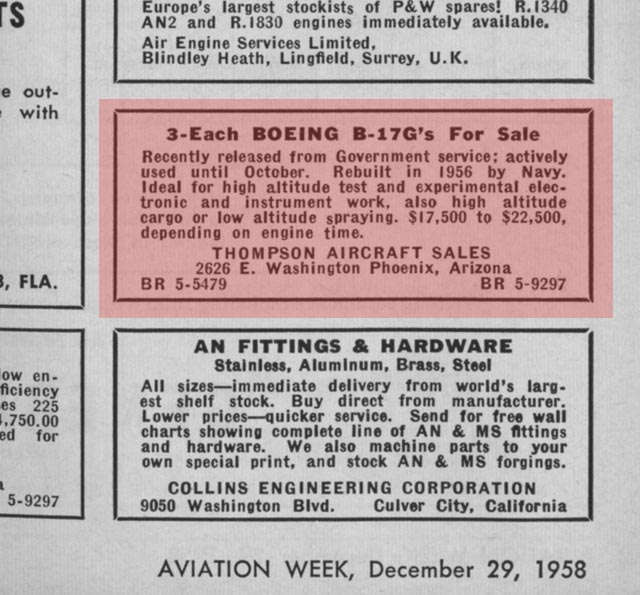
Do you mean you could pick up a surplus Navy B-17 for as little as $17,500 in 1958? What!? Man, $17,500 won't even buy half a Winnebago, flying or not. Oh, if I only had a time machine. I'd buy it, for sure, man, don't you know. Put it on my Visa Card. Those people were fools in 1958, eh, just didn't think ahead? They're probably the same people who didn't start Microsoft in 1958 either!! Wait, doing that math thing again, $17,500 in 1958 dollars is $125,000 in 2007 dollars. Holy turbocharger, Batman! Maybe I couldn't buy it unless I took a third mortgage on my house with a huge balloon payment due next year. But I'm sure it would work out for me. What could go wrong?
Anyway, far be it for me to distract from Nick's provision of the ad, so we are wondering about what three airplanes these were. Well, the ad says the airplanes were actively used until October 1958. It says the Navy rebuilt them in 1956. Hmmm. Quiet; detective at work.... Okay, the Navy retired all of its PB-1Ws by the end of 1956. Thus, we are probably referring here to Coast Guard PB-1Gs. Also, several FAA registration files refer to Thompson Aircraft Sales as a subsidiary company of Ace Smelting, also of Phoneix. Referring to a valued source, that being B-17 In Blue, we learn that before 1960, Ace Smelting did obtain three surplus PB-1Gs, these being CG 77247, CG 77249, and CG 77255. This, in this order, were B-17Gs 44-85821 (N2873G, OB-SAA-532, OB-R-532), 44-85823 (N3192G), and 44-85829 (N3193G). The dates don't line up exactly in their FAA files, but it is evident that some of the registration documents were filed after the fact and that Ace Smelting did hold these three aircraft in late 1958. The known survivior, by the way, is the last airplane, N3193G, now flying as Yankee Lady with the Yankee Air Force.
- Speaking of Nick Veronico and B-17 ads he sent to me, here is another one, this one from Aviation Week of June 17, 1957. This one offers a B-17F for sale or lease by National Aero Leasing of Miami, Florida.
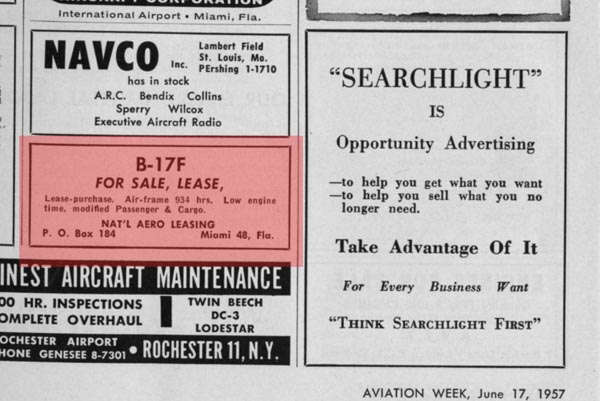
This one is a bit of a question, but I suspect it is actually the B-17F mentioned above, that being 42-3470, known to have been hanging around at Miami during that period and probably available for sale. It also had been modified to carry cargo and probably passengers. Not much known about National Aero Leasing but we will think about this a bit more. If it is actually 42-3470 then that is a really freaky "Circle of B-17" conincidence, eh? Does Elton John know about this?
- Speaking of airplanes east of the Mississippi and north of Key West, there is an update posted by Bob Ready on the Ultimate Sacrifice website regarding the reassembly of B-17E 41-9032 at the Blue Ash Airport near Cincinnati, Ohio. The statement, dated 10/10/07, basically states that the airplane, otherwise known as My Gal Sal, is 95% complete and is only awaiting the construction of a display building in a new park to be developed as part of the Blue Ash airport.
- Well, speaking of B-17s that don't currently fly, Dik Shepherd sent in a bunch of pictures of B-17s he took many years ago while the planet was still cool, back when you could fire up your barbeque without considering the impact of your carbon's imprint. Anyway, the subject of these two photos is B-17G 44-83663 that carried the civil registration of N47780. This was one of the B-17s the U.S. gave to Brazil back in the 1950s and this aircraft served with the Brazilian Air Force, otherwise known as Force Air Brazilian (FAB) until 1968 when the USAF Museum obtained it back in a trade. In the days before base museums, the USAF suddenly remembered that they already had a B-17 in its museum so there was not actually any room in the inn. So, they leased the B-17G to Yesterday's Air Force, a David Tallichet operation. The airplane ended up at Chino parked in the special weeds of Yesterday's Air Force.
It even sported some nose art over the faded remanants of its last FAB markings.
This airplane had a few "challenges" over the next few years, flew very rarely, and the USAF Museum eventually regained control of the airplane and it is now displayed, quite nicely, at the Hill Aerospace Museum near Ogden, Utah. There's some interesting stuff on this airplane out there. Could even be a book. Wait, there is a book: Final Cut.
- Speaking of B-17s that are in Final Cut, here is a media report. The October issue of Smithsonian magazine has an article on B-17E 41-2446, otherwise known as the Swamp Ghost, that doesn't really have any new information but does have some details taken from a personal perspective. There's an online copy available right here. This is, of course, the airplane stuck on the dock in a bay in Papua New Guinea. By the way, for the best and most current information on this B-17E check out the site maintained by Pacific Wrecks located right here.
- Speaking of media reports, hope y'all caught the article in the August 2007 FlyPast on Texas Raiders, the CAF B-17 that has been grounded in Houston for many years. This B-17G is 44-83872 (N7227C) was also a Navy PB-1W (note the "Circle of B-17" tie in, again. Spooky.) The article, by Nigel Price and Duncan Cubitt, is a lengthy piece on the airplane and the efforts to get it back in the air. Included are a bunch of photographs also, so find a copy of the magazine.
- Speaking of Texas Raiders, there is a WIX Forum topic running right now that projects the possibility that this B-17 may be flying again as early as April 2008, in time for the Lone Star Flight Museum airshow held that month. It seems they have a long way to go still, and one hopes that they don't rush the job any....better to have it done all the way rather than just make an airshow. But, when that B-17 returns to the air, it will make a total of thirteen airworthy airplanes out of the 43 complete airframes being held. Not too bad. Could be 17 in a few years.
- Update to the update: Gary Lewis sent in two photos of an airplane that isn't seen too often, B-17G 44-85812 (N4710C). This airplane had come to the civil market from the Coast Guard in 1958 after it had served as PG-1G 77246. Its initial civil owner was Delta Leasing, hauled vegetables and dynamite between Florida and the Bahamas for a few years, and was eventually purchased by Dothan Aviation at Wheelless Airport near Dothan, Alabama. It was used to spray fire ants between 1963 and 1976 when it was destroyed on May 8, 1976, near Blakely, Georgia.
This first photo is from my collection and shows N4710C on the flight line, date unknown.
This second photo comes from Gary Lewis, and shows the airplane on the flight line at Dothan along with a number of the other sprayers owned by Hugh Wheelless and Dothan Aviaiton.
Finally, the sad one, showing the remnants of the airplane after its May 1976 crash. The NTSB brief indicates the airplane had suffered an engine fire in flight, made and emergency landing, and the airplane was eventually consumeed with fire. Neither of the pilots on board were seriously hurt. Gary indicates that the tail section was hauled back to Dothan and probably used for parts. He is trying to track down any more information about what happened to the remaining parts.
- Whew! Well, I think we're all worn out after all that. So, as this November update draws to a close, we must ask "what have we learned?" Well, I think we have proven beyond a shadow of a doubt that the "Circle of B-17" is indeed real, that there is probably a B-17 aura (possibly aqua blue) thing going, and that all the stories of all the B-17s are all connected like one giant, interminable, daisy chain of aluminum and rivets. And, we are one with ourselves. Cool.
September 2007
- Bill Stanczak sent in a little update about the fabrication of some new-build B-17 tube extensions:
"Some progress is being made on getting 2024 tube extrusions. I'm working with a place in Taiwan in getting 2024 aluminum tubes drawn to spec. Problem is that each plane requires a few tubes (and all the tubes are different, so I'm looking for an engineer to look at how to standardize as many as possible to a common thickness.) Hopefully, with the other owners out there, we can get the run funded, and off we'll go, into the wild blue yonder...."
And then he passed along a little B-17 design item that I was not aware of:"I've noticed a few engineering tidbits about the B-17. I've seen it quoted that the B-17B introduced a wing with the outer panel joint further out than it was with the Y1Bs. This is true. They also state that the flap length was increased. This is false. The flaps went from fabric covered to metal covered, but they have had the same length for the entire B-17 run."
This is referring to the joint between the inner and outer wing panels outboard of the engines. I was under the impression that the whole run of B-17s had basically the same wing. Actually, since only 13 Y1B-17s and one B-17A (and one prototype Model 299) were built (out of 12,731), it is pretty much the whole run. Interesting little bit anyway. - Not really news, but Bruce Giles sent in an interesting photo of B-17G 44-6393 taken at RCAF Station Rockcliffe while attached to the U.S. Embassy in Canada. The date is unknown but probably the early 1950s. There have been similar views of this airplane but this was a nice color view. Bruce advises that it is an old RCAF photo.
- Dennis Coley passed along that he remembers seeing a B-17 fuselage sitting alongside Highway 301 in Ocala, Florida, back in the 1960s. Does anybody remember this airplane and can you add anything to this story? Pass it along and I'll post it. Thanks.
- Timothy Spencer recently toured the USAF Museum at Dayton and took these shots of the B-17F 41-24485 under long term restoration. They were originally posted on the WIX forum but Tim let me use them as well. As can be seen the airplane has been completely disassembled. The paintwork on the nose is not the original but was redone later during one of the several restorative efforts made though the years. Many years of work lie ahead for this project but you can expect one completely and authentically restored B-17F when they are done. Fortunately, there is enough historical information on this airplane that they can get the repainting exactly correct.
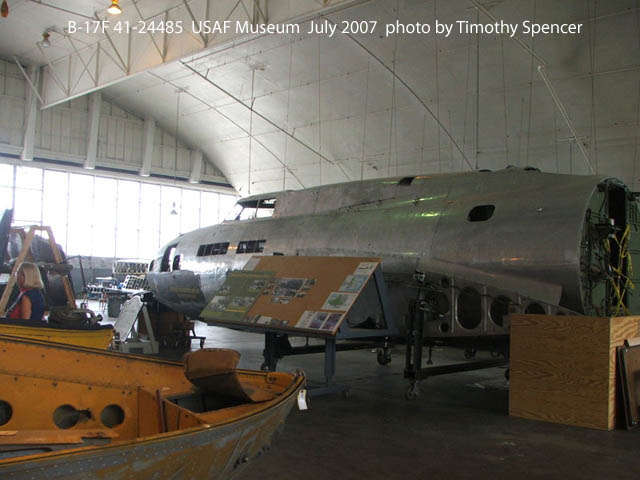
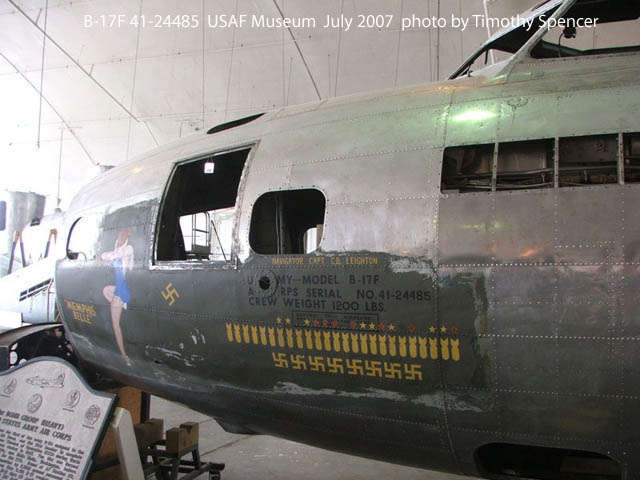
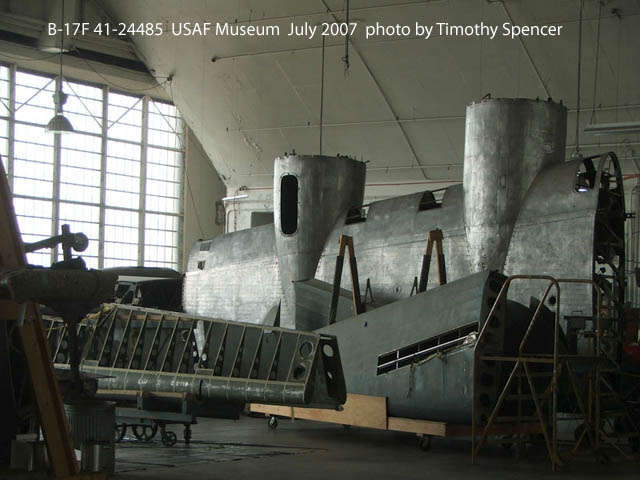
- Dik Shepherd sent in an interesting photo of an unidentified B-17G being christened as, presumably, the Swoose II by Margo Kurtz, wife of one of the pilots of the original Swoose, Frank Kurtz. The photo was taken in 1944 at Lakeland Army Air Base in Florida. As can be seen, the airplane wears an enlarged version of the fusealge art that adorned the original B-17D. Kurtz flew the original airplane after it had ended its combat duty in February 1942, flying VIPs and generals around the Pacific and later Central America. Kurtz was also instrumental in saving the airplane in the post war years so that the NASM could place it in deep storage for a half century and running.
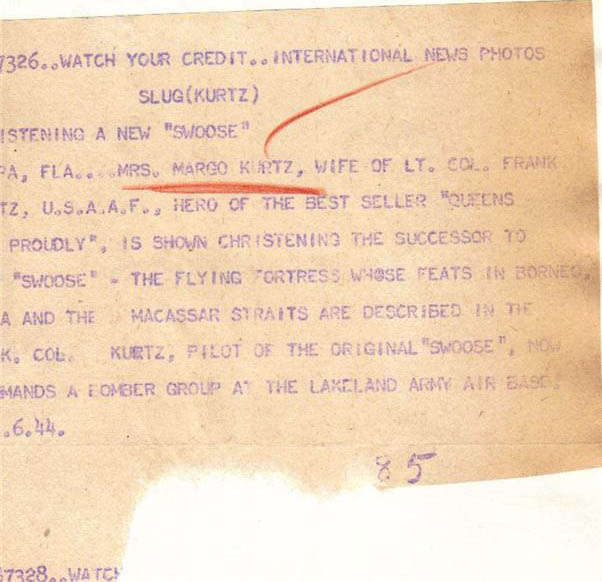
- B-17G 44-85734 (N390TH), as of mid-August, is grounded in Oklahoma City at Wiley Post Airport having an propeller airworthiness directive accomplished. Rumors swirled a bit but it seems the airplane was just due a prop AD and its being done at a convenient place.
- There is a photo spread of B-17G 44-83563 (N9563Z) with an article on flying the airplane by Ray Dieckman in the September 2001 issue of Air Classics.
- Joe Tekarei asks if anyone knows anything about a surplus B-17 that went to the city of Freeport, Illinois in the fall of 1945. He doesn't say, but it was probably as a war memorial. He remembers being taken by his dad to watch it arrive, possibly as early as September 1945. It flew into the local airport named Albertus Field. Anybody have any information about this one?
- In the process of putting together the page on the film Command Decision recently, I dug into my files for information on the B-17G reportedly used in the film, 44-83842. One of my best sources for postwar B-17 information has always been the late Malcolm Gougon, who spent many research slowly compiling information that is now priceless, at least to me. His records indicate the following about 44-83842: It was sold as surplus out of Altus AAF in May 1947 to Bob Sturges (dba Columbia Airmotive) of Troutdale, Oregon, and registered as NL1212N. In February 1948 he sold it to aircraft broker Charles Babb operating from the Grand Central Air Terminal in Southern California. Babb leased it to Warner Brothers for Fighter Squadron in the spring of 1948 and then to MGM for Command Decision. The airplane retained the gun turrets at this time. It was then sold in late June or early July to Israeli interests represented by Al Schwimmer, who had already smuggled three B-17s out of the U.S. bound for Israel. A crew tried to fly NL1212N out of the country during the second week of July. During the first week of July arrangements were made by a company named "World Air Ferries" at White Plains, New York, to purchase 6,500 gallons of avgas to be used to fuel two B-17s and four A-26s. (By the way, the four A-26s referred to here actually have been four Douglas A-20s, N5066N through N5069N, purchased in July 1948 and destined to Israel but interned at Miami instead in August 1948).
When NL1212N showed up on July 11 at 0800, it was marked with the bogus registration of NL7712M. It was fueled and, after a short test flight, immediately departed bound for the Azores. It suffered some engine problems and ended up landng at Halifx, Nova Scotia, where it was imppounded. After a minor international incident, it was released for a return flight to the U.S. on July 16. During that flight, which apparently had the B-17 headed east instead of southwest out of Halifax, ended early when three cowlings blew off the B-17 and it returned to Halifax. After repairs, the Canadians only would authorized a depature if the B-17 was escorted back to the U.S., arrangements for which were made for a July 18th departure. Shortly before midnight on the 17th, though, the airplane departed Halifax without permission and ended up in the Azores.
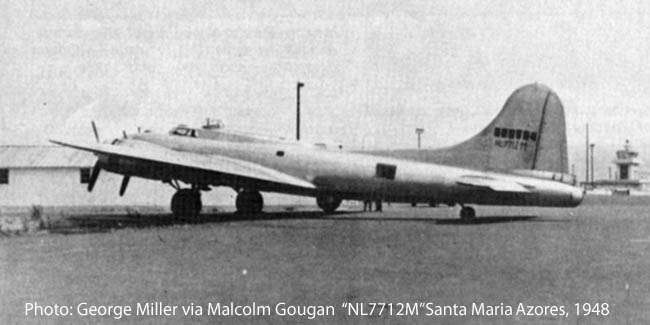
There, Portugese authorities impounded the airplane and crew, the crew later being released to return to the U.S. The airplane's fate is not confirmed, but the best sources would indicate that it was shortly afterwards covertly obtained by the Dominican Republic. Some reports suggest that it was flown into the Domincan Republic in 1951 and became part of its air force flying as FAD 2301. However, Dan Hagedorn's excellent Central American and Caribbean Air Forces notes the arrival of a B-17G in the Dominican Republic in mid-September 1948, which makes more sense in the timeline. Two sources suggest this B-17G later carried the Dominican air force serial of FAD 2301. It remained in service until at least July 1954 but its ultimate fate is unknown.
- With reference to the above and also Dan Hagedorn's excellent book, I would be remiss in not mentioning the Dominican B-17s. Dan's information on these airplanes suggest as many as four B-17s were eventually attached to the Dominican air forces, as follows:
"...two completely stock Boeing (Vega) B-17Gs, complete with functional turrets, guns and bomb bays (ex 44-85756/N9205 and N9206), these also being flown into Andrews Field illegally on 24 February 1947 by U.S. pilots Barry Wympy and Atkins, apparently solo! They arrived bearing only the insignias '9205' and '9206'. Strangely, '9206' departed Ciudad Trujillo briedly on 1 March, destination unknown, and it would appear that this was replaced by another aircraft flown into the DR illegally by Edward Browder, Jr. in August (1947). A U.S. embassy report dated 22 September 1948 stated that yet another B-17 arrived two or three days previously, but this may have been '9206' returning. However, by January 1949, US intelligence counted only two B-17s 'in excellent conditon' on CAMD strength."
In my research, I come to a different conclusions about '9205' and '9206'. Offering too much of a coincidence to be ignored, there were two surplus B-17Es released by the Canadian RCAF in early 1947, and marked only with the RCAF serials of 9205 and 9206 (41-2438 and 41-9142). A. Marino, the noted Argentinean aviaiton historian, records that these airplane were delivered to Argentina in March 1947 after a ferry flight that included a stop at Ciudad Trujillo. The following year civil registrations were assigned, the two becoming LV-RTO and LV-RTP, respectively. This would suggest that the appearance in the Ciudad Trujillo in March 1947 was during their delivery flight to Argentina. Both were old B-17Es, and both had been modified by the RCAF to carry mail and neither had turrets nor guns installed. This view shows LV-RTO in 1947, according to A. Moron.

Based on this conclusion, I think it's reasonable to presume that the Dominican B-17s were only 44-83842, possibly 44-85756, and maybe a third unidentified B-17, though this to me is doubtful. More research is needed, but this is a reasonable conclusion based on sketchy information.
-
Another view of the B-17G Cheyenne tail turret yoke mentioned in the last B-17 update, this time being modeled by Tom Wilson's son Curtiss. Tom is, by the way, the guy turning these parts out from a magic place in Georgia.
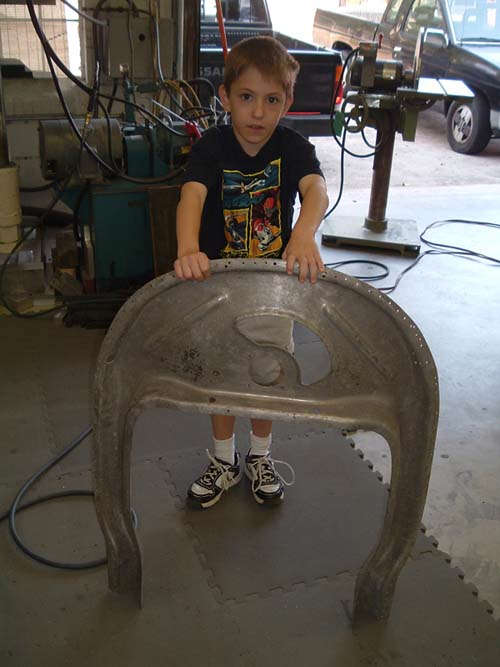
If I'm guessing right, the fact that Tom's son is named "Curtiss" (as in P-40) would be about the same as if I named my firstborn "Boeing." Boy, my wife would have been mad. I might have gotten away with "Douglas" but it's doubtful. Curtiss? Okay, Curtiss is all right, a great name in and of itself. (Actually, if we had a girl I was pushing for "Allison" but I think my wife was on to me by then.)
June 2007
- Well, the B-17 pot is way past overflowing so another update is in order. Thanks much for the contribution of information and photos that poured in over the past few weeks. Some interesting stuff as well as some updates. This is a long one so get out your B-17 Mug, fill it with your favorite beverage, and sit back and relax.
- We shall start with Urbana update #1. By Urbana, we mean Urbana, Ohio, and the restoration progress that is pulling together the remains of at least four B-17s into the serial number of 44-85813. This particular airplane once operated as a five-engine test bed for Curtiss-Wright and flew as N6694C, a civil registraion long since canceled. There's alot more to that story (see, specifically, Final Cut), but the bottom line is that this serial number is the basis for this restoration, and on February 26, this serial number was assigned the FAA civil registration of N3154S. The registered owner is Tech II of Springfield, Ohio, which I think is another way of saying the Shiffer family of Urbana, the owners and prime mover of this project.
- Urbana update #2: Todd Hackbarth visited Urbana, in April 2007 to see the restoration progress of the B-17G now known as N3154S, and he sent in a whole slew of photos of the progress. Here are several from the batch, with pertinent comments added
Above, the forward fuselage of SB-17G 44-83722 under rebuild. The first part of the project, under the direction of noted restorer Tom Reilly, had the volunteers strip the exisitng aluminum skin off the fuselage, afterwhich the underlying structure was repaired. Now, the process of riviting new skin onto the fuselage framework is underway. As can be seen, the nose structure forward of the cockpit has yet to be rebuilt or constructed, and one of the "turtledeck" frames is visible on the top of the fuselage. Also visible is the positioning of the number 3 bulkhead. Too bad there aren't number three bulkheads available. Bummer. No, wait. That's right, see the May update for information about how this bulkhead is being manufactured for several B-17 restorations, including this one.
Above, the aft fuselage section. Incorporated here is structure from the aforementioned 44-83722. Also grafted in here and clearly evident by the olive drab paint, is part of VB-17G 44-83316. The OD paint looks like that part of the airframe came in from New Guinea, but actually it came in from Chino where it had been applied during the filming of the TV series 12 O'Clock High way back in 1964 or so. B-17 experts might note the gap in the fuselage between the forward fuselage and the aft fuselage. This is where, someday, a yet-to-be obtained radio compartment will neatly fit in. Not sure about that structure stuck in where the waist window will go. Presumably, it is up there as a proof of concept development.
Above, the turtle deck assembly that extends from the cockpit aft to the radio compartment under rebuild at Urbana. The access bay opening on the right side of the photo carried life rafts on the standard B-17. Forward of that is where the top turret will go, and forward of that is part of the framework for the cockpit windows.
Above: so, this is what one of the inboard wing sections look like when stripped of the external skin. The front and rear spars are visible, and the corrugated material is riveted to the ribs to provide the beefy, overbuilt wing that the B-17 is famous for. Note how far the wing has been taken down for this restoration. These wing sections are believed to have come from 44-85813, while the outer wing sections will come from 44-83722. Below is a view of right wing inner section in storage with Tim Reilly at Kissimmee, Florida, in 1996, also from Todd Hackbarth. These parts were hauled in from a crash site in North Carolina in the late 1980s.
- Speaking of B-17 restorations, there continues to be progress of the amazing restoration of B-17E 41-2595 at
MarangoMarengaMarengo, Illinois. This decades long effort moves forward, and here are some year old photos of the fuselage work, recently provided by Bill Stanczak.The first is of the aft fuselage, positioned on its side to ease the effort in the area being worked on. The circular cutout is the ball turret opening. Much structural repair has been done to the aft fuselage, including the removal of a large cargo door installed by Boeing in 1942 as this airplane was modified to become the XC-108A for the AAF. A great deal of effort has been done by owner Mike Kellner and his team to ensure that the correct extrusions, properly manufactured and heat treated, were used to make the repairs. This effort is hidden and won't be seen in the final product but it is being done right and to fully airworthy standards. There is much new structure, all manufactured according to the original Boeing blueprints, that is going into this airplane.
Below is another photo of the same section of fuselage, now looking aft from the inside with the right waist gun position at the top and the fuselage floor on the left of the photo. This shows the complexity of the restoration effort. It's not just a matter of riveting in some new off-the-shelf pieces of aluminum ribs and moving on. Care has to be taken to keep the structure straight and true as repairs are made, and the proper materials must be used to ensure structural soundness and an accurate restoration.
This third photo shows the nose section, still detached from the main section of the fuselage, but standing by for rebuild and reattachment. Again, new structure to tie the main fuselage to the nose section is required, all done to the original Boeing drawings. Of interest here is the rare early-style nose piece of the B-17E and earlier versions. The nose piece come from parts unknown, at least to me, but Bill notes that it came to the Desert Rat project painted orange. Using oven cleaner, the orange paint was stripped away and now the framed nose has been fitted in place, at least temporarily.
I've followed this restoration effort since it began in 1985 when Mike Kellner purchase the airplane and hauled it out of a forest in Maine. I have to confess I was a doubter at that time, seeing the massive amount of work required and looking at the limited resources Mike was working with. I was also a bit jealous, but that's another story. But Mike and his crew have proved the doubters wrong, and this airplane is coming together, albeit slowly, but it is being done without shortcuts despite the shoestring budget. As interest grows in the project, I've decided to dedicate some web pages to the effort, with the help of Bill Stanczak and others, and suggest you jump over to the new Desert Rat mini-site for a detailed look at this airplane. Perhaps you should bookmark that mini-site, and maybe you should think about donating some resources to the effort to get the airplane back in the air. It might take another twenty years to put the airplane together, but maybe with some help it can just take another five years. Look forward to more updates here and on the new pages about this impressive project.
- David Braun updates us on the condition of the B-17C wreckage of 40-2047 in the mountains northeast of Placerville, California. This crash site has been discussed on this site in years past and is also included in Final Cut. David visited the site recently and reports on its condition. About the photo below, he notes that this is the starboard wing. "The wing is upside down, and that is the #3 nacelle in the foreground. The #4 engine sheared off when the aircraft began to break up in the air. The wing still has its USAAF star with the red "meatball" in the center plus the remains of "US" for "US ARMY" (US on the starboard wing, bottom; ARMY on the port wing, bottom). There were no signs of compression damage to the spars and trusses, despite falling approximately 10,000 feet straight down. We found only two stress fractures on two ancillary spars. No wonder they called it the Flying Fortress."
He provides the following information about his visit:
"Recently, several of us hiked in to see the crash site and remains of B-17C, s/n 2047. This ship went in one month prior to Pearl Harbor, while on a ferry run from Salt Lake to Sacramento Air Depot (McClellan Field), via Reno, Nevada. The pilots made some questionable decisions after encountering several problems with instrumentation and one engine, eventually resulting in the aircraft going out of control and catastrophic airframe failure aft of Station 5 (radio room). The main debris field is approximately one mile square, and contains several large pieces of the aircraft.
"Of the several websites which discuss this aircraft wreck, very wisely, none disclose the precise location. The U.S. Forest Service website for this district (the Georgetown Divide in Northern California) does not discuss the wreck site at all. Nevertheless, ca. 2001-2002, someone got to the starboard wing and cut out major sections of trusses and spars. The amount of damage is not readily apparent unless you view the wing in person. As to how we determined where the site is located is best left unsaid, but even though a hiking trail is in the vicinity, there is no signage of any kind, nor any kind of apparent trail into the site. The crash site itself cannot be seen from the hiking trail. The isolated conditions have probably saved the remains of 40-2047 from even further damage and vandalism.
"We were able to view the starboard wing (largest section remaining), the empennage (almost unrecognizable thanks to crash damage and 66 years of snowfall), plus miscellaneous shards and pieces of sheetmetal. Since we were in there early, there was still a lot of snow on the ground, and undoubtedly we missed seeing some parts. We will return later in the year. We do wish there was some way of better protecting the aircraft remains, inasmuch this is a War Grave, due to the death of the aircraft commander. A lot more respect should be shown towards these historic Flying Fortress artifacts."
For the above photo, David notes that this is the "starboard wing (upside down), area of #4 nacelle, looking forward. Showing deliberate vandalism damage by cutting away spares and trusses, presumably to sell as scrap aluminum. In order to get at some of the spars, some aluminum skin was cut, then tossed aside." This vandalism has been reported before, and it is the primary reason the site is restricted and the Forest Service is keeping a watch on the site.
- An update on the progress of Texas Raiders, B-17G 44-83872 (N7227C) undergoing a long term repair, maintenance, and restoration at Houston, Texas. Tom Taylor reports...
...that all four engines are ready to be mounted, the two new terminal end connectors are installed and all corrosion has been addressed throughout, rebuilt main gear strutts are now in place and new brake lines are going on, outboard wing segments are ready for installation, main fuel tanks and all new lines are to go in by end of June 07, the tail section is ready to go on, rear stabilizers are in place, all new flooring, all new canvas seat covers, and both new wooden tables are ready for installation. The Norden bomb sight has been beautifully restored, instruments are being calibrated and the props are ready for pickup. All electricals have been inspected and addressed. We expect a return to flight by at least early fall.
Here's a photo shamelessly picked up off the CAF Gulfcoast Squadron website, but shows a view of the airplane in its current condition. That website, by the way, is a great place to keep up to date on the happenings of this veteran B-17.
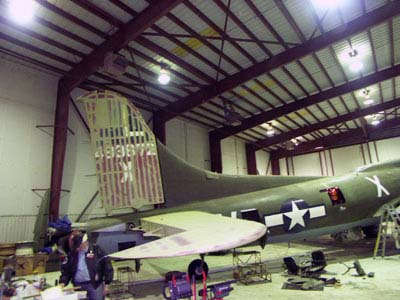
On another note, the Texas Raiders squadron is disposing of a large cache of unneeded B-17 spares and several batches have already been sold. The proceeds from the sales are funding some specialized work on the B-17G and also going into a hangar fund. Check the always-interesting WIX parts site for more and current details.
Texas Raiders has been grounded since 2001, beginning with a costly FAA Airworthiness Directive against the B-17 wing attach bolts and fittings. This CAF B-17G, an ex Navy PB-1W, was actually the first B-17 warbird, being obtained by the then-Confederate Air Force on September 22, 1967 (that's forty years ago, folks), as part of its growing flying museum. Kudos to the dedicated group of volunteers down in Houston for their many years of hard work to get this airplane back into the air. Aside from meeting the requirements of meeting the FAA AD, a process that necessitated the removal of the wings and fabrication of replacement parts, much effort has gone into replacing or updating aircraft systems, and also completing restoration items. Their efforts are paying off and will be ably rewarded when Raiders once again breaks ground, possibly even this year.
- We carried a number of items about B-17F 41-24487, better known as Eager Beaver in the 2006 B-17 News
sections last year. The nose art panel section of this combat veteran B-17F is on display at the Mighty Eighth Air Force Museum at Pooler, Georgia. To see how it got there, look at the February 2006 update item. In any event, I've had the pleasure of corresponding with Kris Waechter, grandson of Leland Kessler, the original artist of the nose art that adorns Eager Beaver who painted it while attached to the 306th Bomb Group in 1943. Kris relates the Leland Kessler added nose art to a total of seven of the 306th's B-17s back in the early days of the air war flown from England. What's amazing is that the Mighty Eighth museum was able to locate Mr. Kessler, and a few years ago they invited him to the museum to 'touch up' the nose art panel that was being displayed. Kris provided these photos of Mr. Kessler and his famous rendering. - Whewww! There's alot of stuff here. It keeps coming, so go refill your B-17 Mug with your favorite beverage. Maybe take a break and order a book for later. Or, have a cookie.
- Back to serious stuff here. No joking around. Okay, Dik Shepherd sent in some interesting photos of B-17F 42-3374 that is now displayed at Offutt AFB, Nebraska. This B-17F was recovered off a MGM studio lot in Culver City, California by Ed Maloney of The Air Museum circa 1970. These photos show the state of the airplane while stored at the studio lot and were taken by Dik in September 1969 on his way home from the Reno Air Races. The first shows the forward fuselage:
Below is a view of the rare Sperry top turret.
And, finally, below is the aft fuselage. It is believe the markings are original AAF. The airframe was transferred to MGM for an as-yet undetermined movie project. This airplane was partially reassembled at Chino and the fuselage was displayed with a an early nose glasss piece fitted. In 1981, it was traded by The Air Museum to the USAF Museum in a deal engineered by Air Pirate Gary Larkins, who moved the airframe to Beale AFB, California, where it was reassembled and displayed for several years. It was finally shipped back to Offutt AFB for display as a gate guard there. The whole story with photos is in Final Cut.
- Bill Stanczak pulled a great still photo from the 1943 movie Air Force out of his files and forwarded it. Here it is:
I'm posting here for three reasons. First, it's a great shot. Second, the movie Air Force is being released on DVD on June 5, 2007. If you don't believe me, and many people don't, check it out right here at Amazon.com. In fact, a review of this movie and the addition of the film to the B-17 Movie page is forthcoming sooner or later. That's pretty cool for a relatively obscure 1943 movie to show up on DVD. And, thirdly, is the continuing mystery of the identity of the B-17 that played the role of the Mary Ann, the starring B-17 in the film. Well, at the end of the last episode (see below, January 2007 update), we had decided that this B-17, long reported as a B-17C, is actually a B-17B!. Eagle eyed people, such as Bill Stanczak, have pretty much established this fact. Now, just because we are the people we are, the people who want to know whether the B-17G-20-BO variant really had twelve widgits vs. the eleven of the B-17G-15-BO, we also want to know which B-17B it was. Well, there were only 39 of the buggers built, so how hard could it be? Pretty hard, I guess, because we still don't know. The airplane in the movie has the tail number of "05584" painted high on the tail, and that translates to "40-5584" which is technically not a B-17 but is technically a ficticious number since the 1940 FY serial numbers only went to 40-3162. It is presumed the 1943 military did not want real serial numbers painted on airplanes because the enemy might be able to derive intelligence from these numbers. So, let's take a look at the number in the above photo, enlarged and reversed for enhancement.
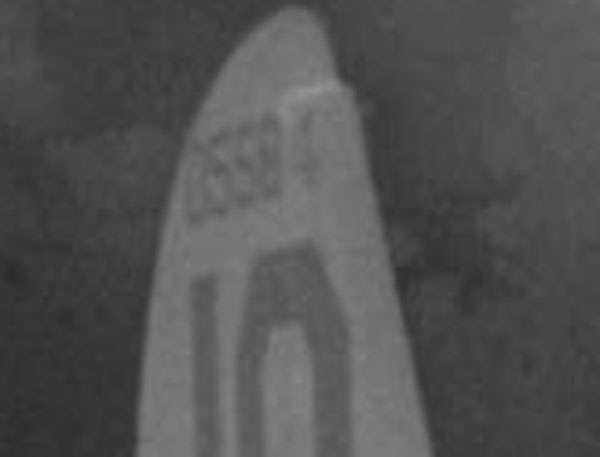
Here is the aforementioned serial of "05584" and this is a B-17B. Hmmm... Of all the B-17B serial numbers ("8211-8223", "8258-8270", "8583-8584", "8610", and "9001-9010"), what would make logical sense to turn into "05584". Based on the way other serials are painted on camouflaged early B-17s, the "4" at the end of the movie serial is probably a confuser...added to the vertical stabilizer instead of the rudder, so the "4" is summarily dismissed. (We're also going to have to look at how the serial is painted on the other side of the tail for this dismissal to be conclusive. but don't let that stop me from speculating.) Thus, with a few brush strokes, "8583" becomes "0558". Could it be that the Mary Ann is really B-17B s/n 38-583? Could be, could be. It bears further investigative reporting and, thus, a request to the Air Force Historical Research Agency to pull the record card for that B-17B to see if dates and assignments might slot into the movie production. The mystery continues, but maybe, just maybe, the first light of dawn is appearing on the eastern horizon. First the Mary Ann and then Amelia! And all right here at aerovintage.com. We may get more once we get the DVD and can zoom in on some digital extracts. Stay tuned for further updates.
- To add to the nice photo Michael Yamada provided for last month's update, he also made available some shots he took at the Planes of Fame Airshow at Chino in May. Here is a nice one of B-17G 44-83563 (N9563Z), which flies as Fuddy Duddy and is based at nearby Orange County Airport.
As a point of interest, Fuddy Duddy and a bird had a meeting, and the bird lost. Fuddy Duddy suffered a bit as well, as this enlargement shows. It doesn't take much of a bird to make an impact on a leading edge.
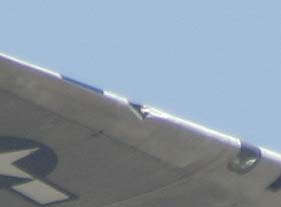
- Dik Shepherd also forwarded this mid-1970s view of Jr. Burchinal's B-17G, 44-83525 (N83525), the ex-DB-17P director that Tallmantz sold to Burchinal in 1972 or so. This photo shows the plane based at Burchinal's little 2,400 foot duster strip west of Paris, Texas. It flew once in awhile in the 1970s and made a brief appearance in the film MacArthur in 1977. Through that decade it continued to wear the 1000 Plane Raid paint scheme applied in January 1968. The vertical stabilizer the airplane had installed at this time turned up at Urbana, Ohio, with that restoration effort, by the way. Most of the rest of this B-17G is in storage with Kermit Weeks in Florida.
- Relating to the news item last month regarding B-17G 42-28160 and its recovery from the Zugersee in Switzerland in 1952, Steve Birdsall forwarded this photo of the airplane being recovered. The photos came to Steve from Hans-Heiri Stapfer and depict the airplane shortly after it emerged from the water. A nose or the nose was later grafted on as indicated by the photos from the May update below.
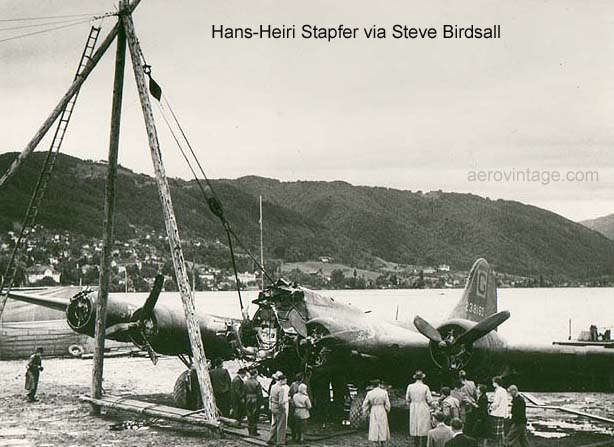
- Noted author, publisher, editor, photgrapher, and wreckologist Nick Veronico passed along some information about the B-17 Cheyenne tail gun compartment modification that was performed on most of the Boeing, Douglas, and Vega B-17G production after 1944. The modification was done by the United Air Lines modification center at Cheyenne, Wyoming, thus the name. The modification increased the room in the compartment and also significantly increased the travel of the twin .50 caliber guns both in elevation and azimuth. Myself, not knowing better, always assumed that the tail gun compartments were scratch built somewhere by some nameless subcontractor and United Air Lines just unbolted the "stinger" tail and added the new Cheyenne tail. Silly me. Nick, who just happens to have a B-17 tail gun compartment, came up with what is a modification kit that changes the "stinger" into a Cheyenne. This kit as Nick got it on E-Bay, apparently came off an obscure, possibly crashed, B-17G. But it does appear that the salvaged parts could modify a stinger to the updated Cheyenne, and a close look at rivet patterns and of the "as-Boeing-intended" construction of the stinger and the Cheyenne modification, it does look like this is all that was needed for the modification. Here is a photo of the kit that Nick purchased and, if you enlarge the photo, Nick's tail gunner compartment also.
- Speaking of tail gun compartments, Tom Wilson down in Georgia continues to work with to produce tooling for B-17 parts, and here are some shots of the tooling for the tail gun compartment yoke for the early 'stinger' tail, courtesy of Bill Stanczak. Mike Kellner sent his tail gun yoke from B-17E 41-2595 down to Tom for him to create a reinforced epoxy mold to be used to press out new yokes. So, you might ask, just what is a tail gun compartment yoke and just how are the oxen hooked up to it? Well, I'm glad you asked. These yokes are the supporting structure that are tied into the aft fuselage and everything else in the compartment are tied into the yoke, sort of. Wait, here's a drawing, also from Bill:
So, here is the tooling part that Tom made:
Bill sends in the following about these parts:
These two pictures are of the stinger-type tail gun "yoke" as it is called. It is a reinforced epoxy mold made from Mike Kellner's stinger enclosure, and will be used to press out several new parts. As the attached drawing shows, the gunner's head enclosure fits above the yoke legs, and the sighting mechanism for the guns is mounted in the flat area in front of the gunner. There is another die to form the flange on the yoke, to which the skins get riveted, but that is not shown. The main piece would be pressed using this die, and then the part would be pressed again using the 2nd stage die, which would bend the correct flange angle on the part. Oh yeah, I should point out that the orientation of the yoke on the table is upside down. If there was a gunner, his head would be in the table, and his legs pointing at the ceiling.
And, another view of the tooling part:By the way, the yoke for the Cheyenne modified tail gun compartment is a whole different part, and Tom reports it would be much more difficult to manufacture. Here is the Cheyenne yoke highlighted from Nick Veronico's Cheyenne kit, and you can see it is more complex.
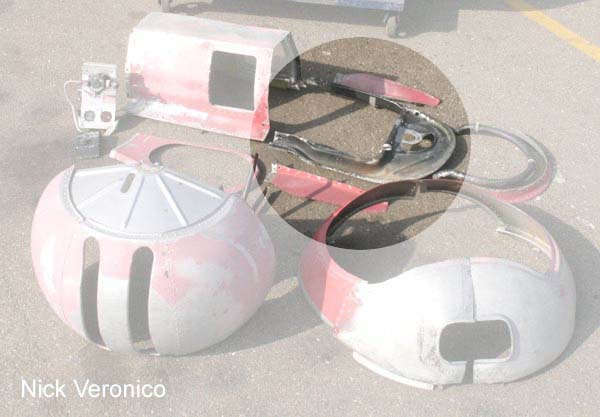
- Well, that's about it for June. That's a lot of material, but by now you're so excited about B-17 stuff you don't know what to do. So you should probably buy a book and satisfy that B-17 urge. Sometimes a mug just isn't enough.
May 2007
- Bill Stanczak sends word about the number three B-17 fuselage bulkhead top piece stretch die is complete and ready to go to work. As exciting as that sounds to most people, not everybody is sure what this exactly means. It actually is possible that nobody knows what this means, but as far as can be determined, it might mean something like this: the number three bulkhead on the B-17 fuselage is the one just forward of the cockpit instrument panel and separates the nose compartment from the cockpit. The top part of the bulkhead, that part that the stringer structure is attached to, is constructed from a straight piece of a "double-tee" aluminum alloy extrusion. Here is a drawing with the specifications for the extrusion (side view):
This extrusion has to be custom manufactured these days, and then heat treated. An order has been placed with expected delivery this summer. It's hard enough to arrange for the correct extrusions to be located and/or manufactured, but it isn't a matter of just bending the straight piece of extrusion into the correct shape and riveting some aluminum skin to it. The number three bulkhead top piece is a complex part with multiple flange angle changes. Working from the original Boeing blueprints of the part, a stretch die was reverse engineered to allow the part to be manufactured. Here is a copy of part of the blueprint.
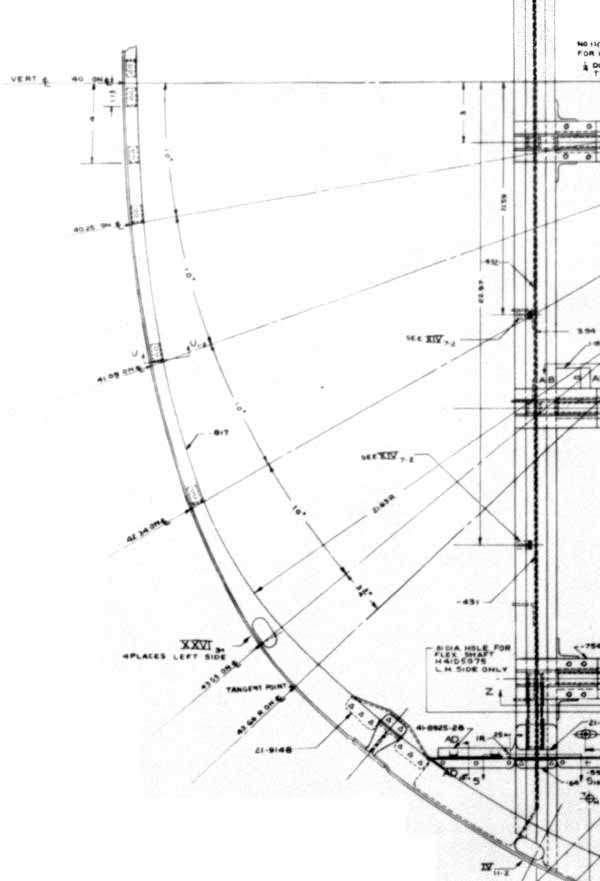
As one can see, this is not a simple part and not a simple task to design and build something to make the part. From all indications, the stretch die is designed to take the straight pieces of extrusions and stretch pull them into the proper shape without deforming the extrusion. The stretch die photos shown below has a drilling guide attached so that the bulhead top piece can be pre-drilled for the latter stringer and skin attachments. Bill thinks this is how Boeing originally built the parts. And, to give credit where credit is due, Tom Wilson out of the Atlanta, Georgia, area, constructed the stretch die. Tom is very involved in building new parts and tools to build new parts for old airplanes, particularly B-17s and P-40s. Anywhere, here is a photo of the stretch die:
If the drilling guide is removed, the two channels that accept the legs of the extrusion would be visible. The amazing thing to me is that such an effort is being made to create virtually new structural parts for the B-17. Bill reports that, though he is deeply involved in the restoration of B-17E 41-2595, otherwise known as Desert Rat, this part is not needed on that restoration. Instead, it will help create new bulkheads for the Urbana restoration, 44-85813 (more or less), and the Don Brooks restoration of 44-83790. Next up for bulkheads: jigs and or dies for the construction of fuselage frames 8, 9, and 10 in the aft fuselage. Very impressive effort and a clear demonstration of a dedication to quality and soundness a couple of steps above what is often found. Kudos to the continued effort, and thanks to Bill for providing the information. Good stuff.
- Shawn Sonnentag passed on some photos of the remanants of B-17G
42-97619 that he located in the Telegraph Mountains about 10 miles east of Yuma, Arizona. As can be seen, there isn't much left of the airplane, but Trey Brandt passed along a few details of the accident that put the B-17 in those mountains. On the night of June 28, 1944, the B-17G was returing from a night navigation mission and was lining up for the final approach into Yuma when it was accidently flown into the mountainside. All five crewmembers aboard were killed. At 02:30 a.m., some nearby railroad workers witnessed the accident and reported seeing a large orange explosion on the mountaintop and thought it was an errant bomb. Here are two photos taken by Shawn Sennentag from a selection available here. 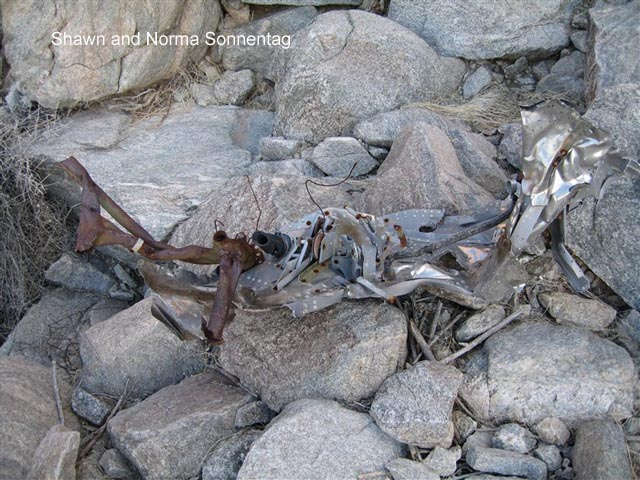
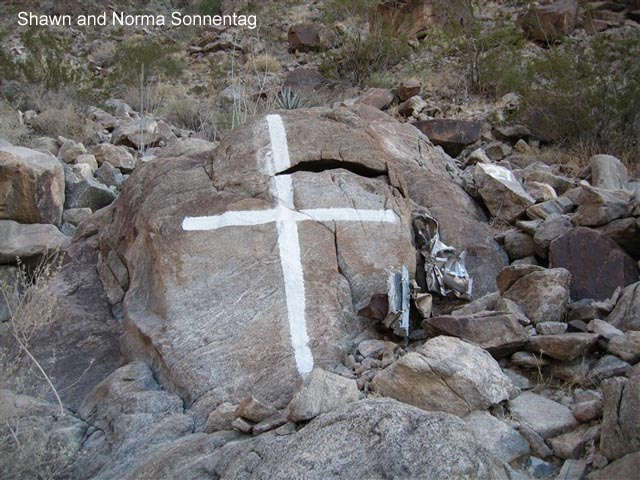
B-17G 42-97619 was delivered by Vega on January 7, 1944 and assigned to the 3036th Base Unit at Yuma two weeks later. Its service was shortlived. Within six months, it spread across the side of the mountain where parts remain to this day.
- Eric Roscoe started an interesting thread about a B-17G that was pulled out of the Zugersee in Switzerland in 1952. This B-17G, 42-38160, which flew for the 385th Bomb Group as Lonesome Polecat was lost due to enemy action on March 16, 1945. All crew except the navigator escaped by parachute before the airplane crashed into the water and sank. It was recovered in 1952, put back together in a fashion, and toured as a display for a year. Evidently, it then was stored in a field near Suhr, Switzerland, until sold for scrap in 1972. Thanks to Eric who shared these photos with the forum. They were taken on May 31, 1966, presumably at the field near Suhr.
And, here's a photo from an unknown source of the same airplane assembled and on display in earlier years. The photo also illustrates how Americans and the current crop of "really cool" guys don't have exclusive rights to vandalism and graffiti:
- Just a tidbit here, and I'm not going to divulge further, but I was recently contacted by someone who had a B-17E nosepiece framework. He passed along that this part was saved by his grandfather, who worked on B-17s in the states during World War II and brought a lot of pices of old airplanes back to his farm after the war. Most are now completely deteriorated, including fuel tanks, tires, etc., but the the nose piece remains in very good shape. All the Plexiglas is broken out, but the frame is complete with only a few dents and scrapes. At this point, the individual is not looking to sell the part as it has sentimental value. Besides the rarity of the part, it is interesting how this stuff keeps turning up.
- Just a reminder to all out there of a great B-17 photo websource: Ron's Archive. Check it out for some rare photos of B-17s, particularly air tankers. Here's a sample:
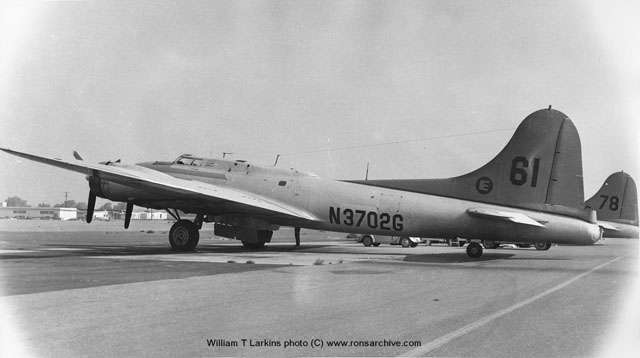
Also, check out Win Jack's site for some other great galleries of interesting photos of B-17 air tankers. Some good stuff out there on the web. Thanks to Peter Green for the reminder about the Win Jack's site.
- Going back to this photo posted in the January 2007 update:
Steve Birdsall, a long time excellent source for B-17 information, sends along some possibilities about this photo. Based on the overpainted but obvious nose markings, he thinks this would be one of the B-17Es flown home from the South Pacific when the B-17s were finally replaced by B-24s in 1942. They had original nicknames but additional "generic" markings were painted on the nose, possbily while they were in New Caledonia at the 13th Air Depot. These made-up markings consisted of a panel of Japanese aircraft and ship stencils, bombs stencils, and sometimes purple hearts, as seen in the two B-17s below.
(This photo is a Boeing photo from Steve's collection, and shows an unidentified B-17E on public display, presumably in the U.S.)
(This photo is a Charles Phillips photo from Steve's collection, and shows B-17E 41-2609 as flown by Charles E. Phillips after a ferry flight from Hawaii to Tinker Field, Oklahoma.)
In both photos, it is interesting to note that the markings are similar and that in the original photo, such a panel has evidence of being overpainted. In many cases, these tired B-17Es were assigned to training units, most likely the course taken by 002, though the actual identity of this aircraft remains unknown. Thanks to Steve for passing along the info and photos.
- Steve Birdsall also passed along this circa 1965 view of the fuselage and tail of B-17G 44-83316 on the TV series 12 O'Clock High set at Chino, California. As can be seen, the airplane was used as set dressing, moved around as needed to provide the appearance of a second B-17 on the field. In this case, the set's mock control tower almost hides the fact that the airplane has no wings.
- Since the subject of 44-83316 came up, it happens that back in the 1963-64 time frame Tallmantz Aviation and 20th Century Fox were in a dispute about getting the airplane then parked at Norton AFB in San Bernardino. Possession of cockpit parts being nine tenths of the dispute, the movie studio gutted the cockpit for their B-17 mockup and Tallmantz went fuming to the USAF for another B-17G. Later, this ex VB-17G lost its wings and went to Chino, and yet later parts went into several restorations, and today the few remaining parts of the fuselage are at Urbana, Ohio, for use in yet another B-17 project. The point is, the cockpit was gutted at Norton in 1963. Do you have doubts? Dik took a picture of the airplane later when it was part of the Chino set.
- Brian passes along the following request: "Greetings fellow B-17 followers. I am writing to ask if any of you know where I might find an authentic and original B-17 control wheel/yoke for sale. Yes I know they aren't cheap. If you know of someone who has one they might consider selling, could you please email me at: bsigg@comcast.net. I appreciate any help you can offer."
- Okay, finally a pretty cool photo from the camera of Mike Yamada, showing a beautiful view from the top turret of B-17G 44-83575, otherwise flying the west these days as Nine-O-Nine. Thanks, Mike, for passing it along.
- Eric Roscoe started an interesting thread about a B-17G that was pulled out of the Zugersee in Switzerland in 1952. This B-17G, 42-38160, which flew for the 385th Bomb Group as Lonesome Polecat was lost due to enemy action on March 16, 1945. All crew except the navigator escaped by parachute before the airplane crashed into the water and sank. It was recovered in 1952, put back together in a fashion, and toured as a display for a year. Evidently, it then was stored in a field near Suhr, Switzerland, until sold for scrap in 1972. Thanks to Eric who shared these photos with the forum. They were taken on May 31, 1966, presumably at the field near Suhr.
March 2007
- The clamoring crescendo (1 person) for a B-17 News update has finally risen to a level to which I must respond. The first bit out of the chute involves what has become known as the Greeley B-17, a clever moniker for that B-17 fuselage that was hung somewhat anonymously for two decades in the State Armory Bar in Greeley, Colorado. Here are some photos of the airplane as it was lowered from the bar ceiling. These photos are all courtesy of Jim Clark of Clark Construction Co. of Greeley:
This view shows the forward fuselage section before it was lowered. The bomb-bay section has already been removed and lowered. The company hired to do the removal was Clark Construction Company, and they not only had to disassemble the fuselage and lower it, but also had to open a wall in the building to get the parts out. Les Chapman hauled the airplane once it was loaded on a truck.
Here is the cockpit section partially lowered. This gives a good view of the side of the cockpit cut away. There is no doubt now that this was the fuselage prop used for the production of the TV series 12 O'Clock High between 1964 and 1967. The interior sets were located at the Fox Studios on Western Ave. in Hollywood, and the airplane parts of the set consisted of a B-17 fuselage from nose to the aft end of the radio compartment. A second section was a replica aft fuselage, studio constructed, consisting of the waist aft to the tail wheel bay. When 20th Century Fox was liquidating their Malibu sets in the early 1970s, this fuselage was present along with, possibly, a studio-constructed replica nose. It was purchased by the owner of Grand American Enterprises, a company that operated a series of themed restaurants. The B-17 fuselage ended up being moved to Greeley and mounted on the ceiling of the bar/restaurant in the summer of 1978. It has remained there ever since, though has been the subject of numerous offers of purchase. Last year, with the impending sale of the building, the Urbana group rebuilding 44-83722/44-85813/44-83316 came through and, as part of a sale, stripped the ball turret and other parts from the hulk. Then, early this year, a new group from California purchased the remains of the airplane. It was this group that arranged for Clark Construction to disassemble and remove the airplane, which took four men four days to accomplish. In early February, the airplane was being moved to Southern California. The actual identity of the airplane remains unknown, but it could very well be 44-83387, the original B-17G obtained by 20th Century Fox in 1949 from the USAF for the filming of the 12 O'Clock High movie.
The new owners are still formulating plans for the airplane, and we'll announce those intentions as soon as they become known.
And here is the esteemed Mr. Jim Clark at work on the B-17.
- A photo of this B-17G recently appeared on E-Bay for sale:

As can be seen here, the photo is dated July 1952.
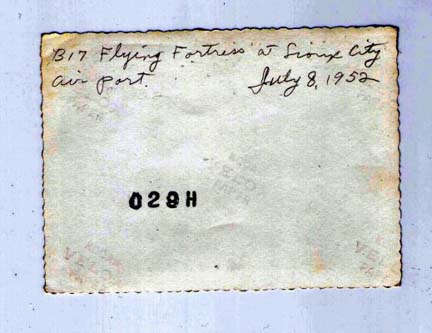
Though not conclusive, this suggests the photo is of the elusive B-17G s/n 42-102542. This airplane was one of the many B-17s and other warbirds that went to communities and groups as war memorials, placed on display as part of government program administered by the Reconstruction Finance Corp., later War Assets Administration. In 1946, this particular B-17 was placed on permanent loan with the City of Sioux City, Iowa. The city nominally gave the airplane to the local American Legion post for display at the local airport. It was displayed at the airport from 1946 to 1952, and this photo probably depicts the airplane at the airport. It appears to be intact with gun turrets installed, and in fairly good conditon.
The American Legion post then "sold" the airplane, in August 1952, to Lysdale Flying Service of South St. Paul, Minnesota. Of course, neither the American Legion post nor the City of Sioux City actually owned the airplane, and Lysdale Flying Service negotiated a release/transfer agreement with the General Services Adminstration that, for the sum of $12,350.97 ($93,953.00 in 2006 dollars), granted title to the new owner. The paperwork flew between South St. Paul, Minnesota, and Washington, D.C. but, in June 1954, nearly two years later, the airplane was registered as N5845N. This may be the airplane being run at Fleming Field circa 1954.
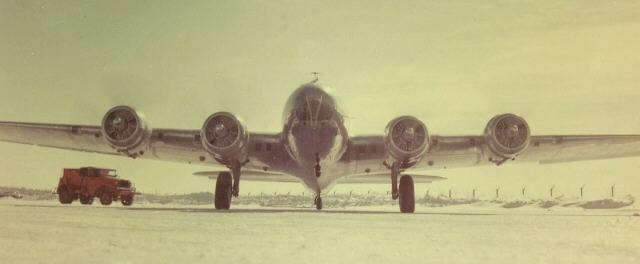
In February 1955, it was sold to Aero Services Corp. of Philadelphia and modified for aerial survey. It was ultimately destroyed in a 1955 accident in Afghanistan. No photos of the airplane in Aero Service service have surfaced.
- Pat Carry sends along an update from the Friends of the National Museum of the USAF journal for Winter 2006/2007 on B-17F 41-24485, otherwise known as the Memphis Belle. In an article by Maj. Gen. Charles Metcalf (ret.), the director of the museum, it is noted that the airframe is undergoing continuing stripping. More corrosion is being found, particularly in the ball turret area and the tail area below the vertical fin. That area has had to be competely disassembled and some major structural frame members removed. Stringers in the area have to be replaced, as will the frames. The frames will be manufactured by the museum using a special hydraulic press. The fuselage has been placed in a jig for this work to retain the fuselage alignment, and a laser alignment will be accomplished to assure proper realignment. No timetable is included, but it is presumed this may be a decade long project. Best to get it right, though, to ensure this airplane is completely and finally restored.
January 2007
- Robert Johnson sent in a request to try and identify what appears to be a B-17E that his father was involved with. No details are available but the nose markings would suggest the airplane is assigned to crew training.
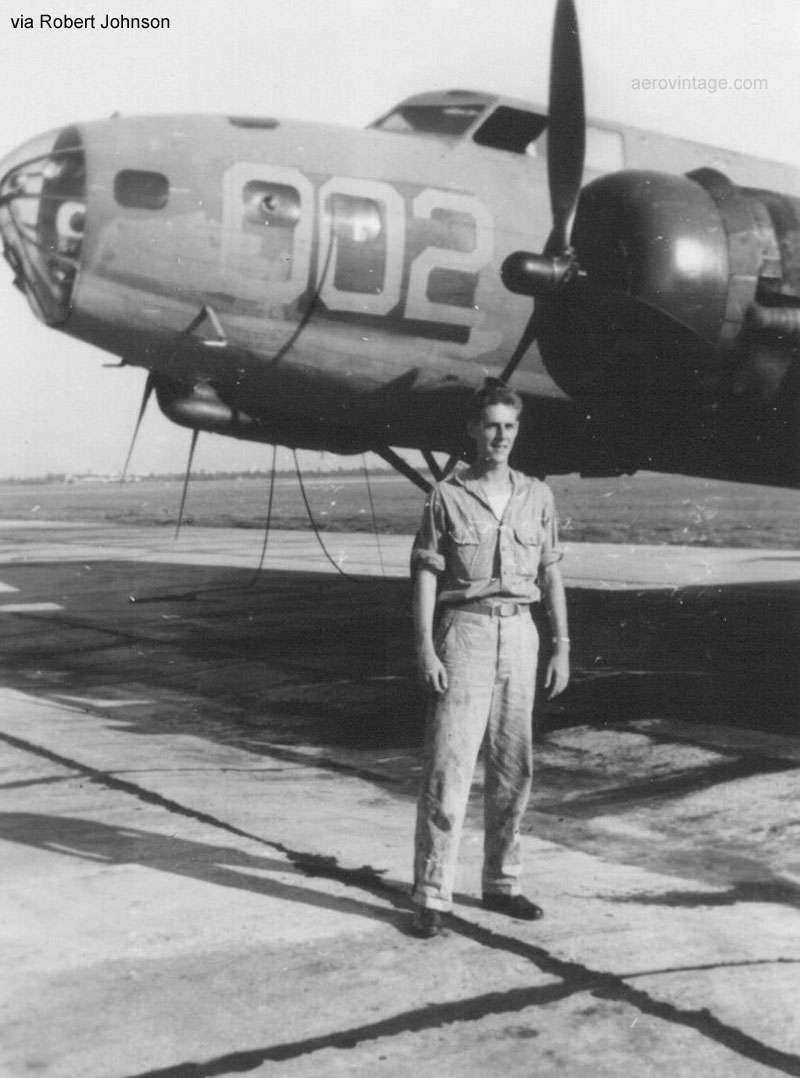
- Peter Green forwarded 'the rest of the story,' in this case, the rest of the story being the right side of Sally B, 44-85744 (G-BEDF), after its fall 2006 repaint, both taken in October 2007. First, a closeup of the updated noseart:
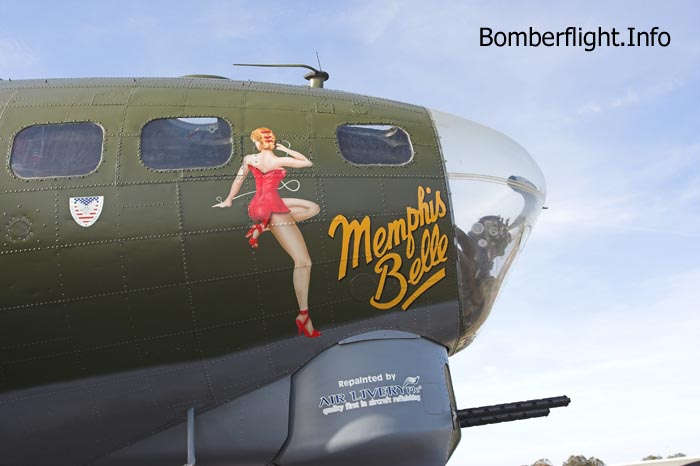
And then, a nice shot of the airplane airborne. Note the retention of the checkerboard pattern on the #3 engine, in rememberance of Ted White, the guy who brought the B-17G to the UK back in 1975 and who later was killed in a 1982 crash.
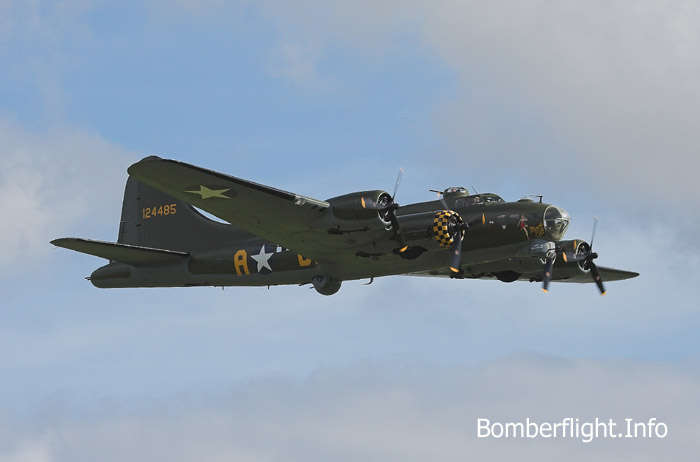
- An interesting trend continues to develop as craftsmen of the skilled variety are increasingly producing new structural parts for old airplanes, B-17s in particular. Spearheading the effort is the team led by Mike Kellner working to restore B-17E 41-2595. Bill Stanczak, a member of the team, has arranged for the new production of bulkheads, stringers, and other hidden but vital structure that is essential to an airworthy aircraft. It's not just a matter of banging out some aluminum or casting a new part; such airworthy components have to meet or exceed the original part's specifications and often require special tooling, extrusions, and heat treating. Bill has posted several messages about the availability of new parts on the Aero Vintage website forum, most recently regarding new carry through spar tubes. There are several talented individuals building new parts for B-17s (and P-40s, and others) that will allow cracked, broken, corroded, rivet-strewn but critical parts from sixty year old airplanes to be reverentially retired.
- Speaking of the Aero Vintage forum, an interesting series of postings have discussed the 1943 movie Air Force that featured much footage of early B-17s. In particular, the discussion has centered around the B-17 star of the film, the Mary Ann, that has identified in books and other material on the film as a B-17C. Well, eagle-eyed researchers, among them the above-mentioned Bill Stanczak, have determined from little cowling variations that it actually was a B-17B with fuselage modifications to the B-17C standard. This photo, from a Jeff Ethell book, is pretty conclusive:

Two items give the B-17B away: the exhaust collector assembly exits the #3 engine through a notch in the engine cowl, changed on the B-17C to eliminate the notch, and the location of the air intake on the #4 engine. On the the "B," it is mounted directly aft of the break between the nacelle and cowling; on the "C," it was mounted about six inches aft. Also, the nacelles on all the engines curve into the cowling at a steeper angle on the "B"s than on the "C"s. It appears that at least several of the B-17B fuselages were rebuilt (by Boeing?) to the B-17C standard with updated gun mounts and nose framing. Curious, curious, as this has not been documented in any of the dozens of books, even the best books, on the B-17 (save the first B-17B, 38-211, reworked to the eventual B-17C configuration at Wright Field for early testing). Leave it to eagle-eyed B-17 experts to uncover such a thing, and leave it to us to care about it.
- Taigh Ramey, he of Vintage Aircraft at Stockton, California, recently posted some photos on the WIX forum site, including these of the current condition of B-17D 40-3097, better known as The Swoose in eternal storage with the NASM:
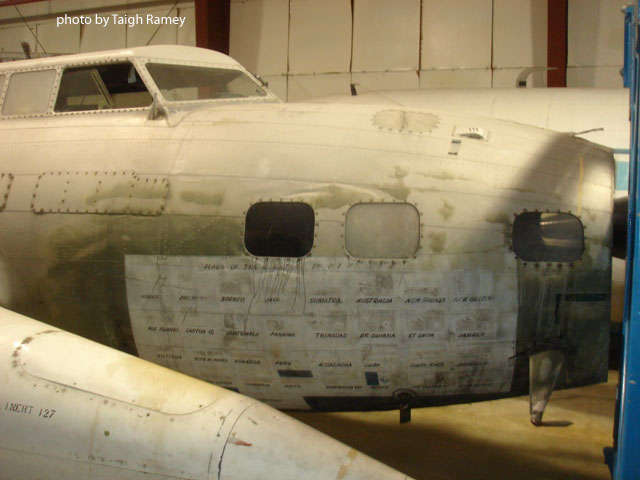
And, a rarely seen view from the inside of the cockpit:
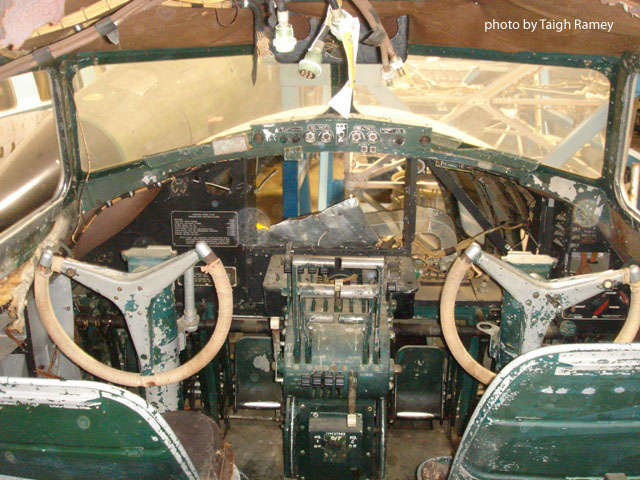
I won't mention what a shame it is that this airplane remains out of sight and out of the collective NASM mind. I won't mention that. Nope, I won't.
- Not news, but this photo of SB-17G 44-83722 has been around the internet a time or two so I thought it should show up here also. This is the airplane after it sat through a few atomic tests in the 1950s/1960s in Nevada. It went on to be used for air tanker parts and then sat in the desert for a few decades. It's the better part of the B-17 rebuilding effort going on at Urbana, Ohio, the website for which is here.
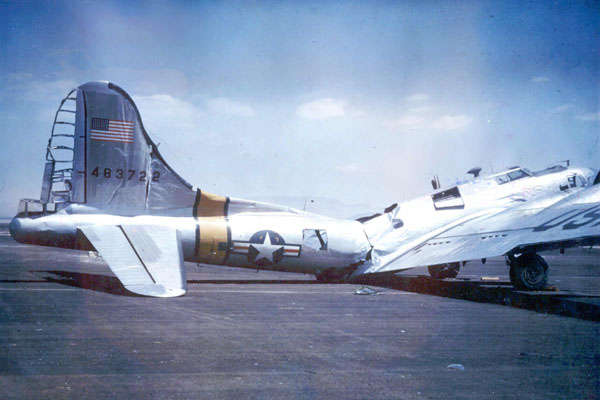
- Finally, rumors abound about the status of Swamp Ghost, B-17E 41-2446, and its current condition. From my persepective, the less said the better at this particular point, so I am saying less.
B-17 News Archive
2018 B-17 News
2017 B-17 News
2016 B-17 News
2015 B-17 News
2014 B-17 News
2013 B-17 News
2012 B-17 News
2011 B-17 News
2010 B-17 News
2009 B-17 News
2008 B-17 News
2007 B-17 News
2006 B-17 News
2005 B-17 News
2004 B-17 News
2003 B-17 News
2002 B-17 News
1997-2001 B-17 News
Back to B-17 Information
Back to the Main Page
Updated:
